The paleofauna of the Eocene Okanagan Highlands consists of Early Eocene arthropods, vertebrates, plus rare nematodes and molluscs found in geological formations of the northwestern North American Eocene Okanagan Highlands. The highlands lake bed series' as a whole are considered one of the great Canadian Lagerstätten. The paleofauna represents that of a late Ypresian upland temperate ecosystem immediately after the Paleocene-Eocene thermal maximum, and before the increased cooling of the middle and late Eocene to Oligocene. The fossiliferous deposits of the region were noted as early as 1873, with small amounts of systematic work happening in the 1880-90s on British Columbian sites, and 1920-30s for Washington sites. Focus and more detailed descriptive work on the Okanagan Highlands site started in the last 1970's. Most of the highlands sites are preserved as compression-impression fossils in " shales", but also includes a rare permineralized biota and an amber biota.
The 1,000 km (620 mi) series of lacustrine deposits are located across the Central British Columbia, Canada southeast to northern central Washington state, United States. grouped informally into "Northern", "Central", and "Southern" sites. [1] The Northern sites consist of unnamed Ootsa Group formations which outcrop as the "Driftwood shales" near Smithers, British Columbia, the " Horsefly shales", of an unnamed formation and unnamed group which outcrop around Horsefly, British Columbia, [1] and possibly sites now considered lost in the Quesnel, British Columbia area, [2] The Central sites represent Kamloops Group formations with the McAbee Fossil Beds, Tranquille River site and Falkland site, all in the Tranquille Formation, the Quichena site and Stump Lake site in the Coldwater Beds and outcrops of the Chu Chua Formation near Barriere, British Columbia. The Southern sites include the Princeton Group Allenby Formation sites surrounding Princeton, British Columbia, such as "Nine Mile Creek", "One Mile Creek", "Pleasant Valley", "Thomas Ranch", "Vermilian Bluffs", and "Whipsaw Creek". The Penticton Groups Kettle River, Marama and Marron Formations in the Boundary District along the Canada-United States border are closely correlated with the Klondike Mountain Formation across the border. [3] The most southerly of the Okanagan Highlands lakes, the Klondike Mountain Formation in Northern Ferry County, Washington include the "Boot Hill site", "Corner Lot site", "Gold Mountain site", "Knob Hill site", and "Mount Elizabeth site". [1]
There is debate as to the affiliation of the, potentially lost, Quesnel sites with the Greater Okanagan Highlands. Archibald et al. (2018) in a monograph of the Highlands Hymenoptera families included them as part of the series. [4] However the certainty for the placement was questioned earlier by Eberle et al. (2017) [5] and Archibald and Cannings (2022) who opted to tentatively exclude Quesnel from the highlands while discussing the history of field colleting in the region. [2]
Fur Formation (left), Okanagan Highlands (right)
The Okanagan highlands represent a snapshot of lake, wetlands, and montane forest animal life which existed approximately 15 million years ago after the Cretaceous–Paleogene extinction event. The temperate upland lakes hosted insects, fish, birds, and mammals with the notably well preserved megafossils often retaining insect colour patterns, gnat wing membrane hairs, and whole bird feathers. [6] In some cases the fine detail preservation of soft parts allows for the preservation of internal anatomy. [7]
Archibald and Makarkin (2006) suggested the disjunct distribution of genera between the Danish western Limfjord coasts Fur Formation and the Okanagan highlands may have been enabled by rising crust elevations in the northern Atlantic region and subsequent increase in landmass during the Late Paleocene which linked Northern Europe with Greenland until at least the Early Eocene. [8] Several land bridge routes may have acted as migration corridors for biotic interchange, the northern De Geer land bridge from Fennoscandia to North America via northern Greenland, and the southern Thulean land bridge from northern Britain though the Faroe Islands and then Greenland and North America. Several insect genera share disjunct distributions between the highlands and Limfjord including the mecopteran Cimbrophlebia, the giant lacewing Palaeopsychops, the green lacewing Protochrysa, the bull dog ant Ypresiomyrma. [8]
The Hat Creek Amber deposits in the central region provide evidence for small and microbiotic elements of the Okanagan Highlands forests though entombed organisms such at terrestrial nematodes and microwasps that otherwise would likely not be preserved in the lake environments. [9] The highlands as a whole have been described as one of the "Great Canadian Lagerstätten" [6] based on the diversity, quality and unique nature of the biotas that are preserved. The highlands temperate biome, preserved across a large transect of lakes, recorded many of the earliest appearances of modern genera, while also documenting the last stands of ancient lines. [6] David Grimaldi et al. (2018) during discussion of inclusions in Alaskan Chickaloon amber, noted the Okanagan Highlands record of latitudinal extinctions, specifically the modern southern hemisphere endemic groups Eomeropidae mecopterans and Myrmeciinae bulldog ants. [10]
The majority of the lake deposits are compression fossils in lake bed sediments noted for both the paleofauna and paleofloras, with an additional pair of important non-compression biotas. A permineralized chert flora, the Princeton Chert is found along the Similkameen River interbedded with coal deposits of the Ashnola shale unit, Allenby Formation known for anatomically preserved plants. [11] In the Central sites, subbituminous coal of the Hat Creek Coalfield around Hat Creek hosts an entombment biota, the Hat Creek amber, which preserves highlands faunal elements that are not found in the compression biotas. [9] [4] Initial discussion of the amber presented by George Poinar, Jr. et al. (1999) suggested the Hat Creek amber producing tree was likely to be an araucarian tree in the genus Agathis, based on unreported magnetic resonance spectroscopic analysis and earlier reports of the genus in Mesozoic Canada. [12] A purported occurrence of Araucaria at the McAbee site was used as additional support for the ambers origin. [13] The Agathis origin for Canadian Mesozoic amber was later called into question by Ryan McKellar and Alexander Wolfe (2010) based on a lack of any araucarian macrofossil history in the northern hemisphere [12] the McAbee fossils having been already reidentifed as from the cupressaceous Cunninghamia. [13] Based on Fourier-transform infrared spectroscopic analysis and associated amber inclusion fossils, they suggested the Mesozoic ambers of Canada to be from the extinct cupressaceous genus Parataxodium. [12] The origin of the Hat Creek ambers was further noted as likely from a cupressaceous source by Grimaldi et al. (2018) who call out a primary floral component of the host coal being Metasequoia and that the coeval Puget Group Tiger Mountain amber of Washington state is also of Metasequoia origins. They hypothesize that the major amber producing plant of the Paleocene Pacific Northwest forests as Metasequoia, but note that further investigation of Chickaloon, Hat Creek, Coalmont, and Tiger Mountain ambers would be needed. [10]
Mollusks are a rare component of the highlands, usually being mentioned only in passing, such as by Mark Wilson (1977, 1978), [14] [15] and with fossils being reported from three sites only. A series of species were described from several Allenby Formation sites around Princeton by Russell (1957), who documented 4 gastropod species, and tentatively identified to genus another gastropod and a bivalve. [16] Additional unidentified small bivalve fossils were mentioned from the Pleasant Valley site by Wilson (1977) and the Quilchena site by Wilson (1987), [17] while unidentified gastropods were briefly mentioned by Kathleen Pigg et al. (2018). [18]
| Family | Genus | species | Sites | Notes | Images |
|---|---|---|---|---|---|
|
A hydrobiid mud snail |
||||
|
A lymnaeine pond snail |
||||
| Physidae |
|
An aplexine bladder snail |
|||
|
A physine bladder snail |
||||
| Planorbidae |
|
An ancylinine ramshorn snail |
|||
|
Indeterminate [16] |
|
A possible planorbinine ramshorn snail |
|||
|
Indeterminate [16] |
|
A possible sphaeriine fingernail clam |
|||
|
Unidentified |
Unidentified |
|
Unidentified freshwater bivalves. |
||
|
Unidentified |
Unidentified |
Unidentified [18] |
|
Unidentified freshwater gastropods. |
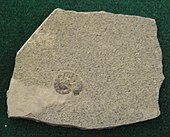 |
In the initial description of Hat Creek Amber, Poinar et al. make note of nematode specimens found in the deposit, with a brief commentary regarding them as the oldest terrestrial free-living nematode fossils to have been found up to that point, but did not give any specific taxonomic identification beyond that. [9]
| Family | Genus | species | Sites | Notes | Images |
|---|---|---|---|---|---|
|
Unidentified |
Unidentified |
Unidentified [9] |
|
Unidentified terrestrial specimens in amber |
A single arachnid has been described fully from the Okanagan highlands, the Nursery web spider Palaeoperenethis thaleri, known from an adult male. This spider was likely aquatic as are the other members of the family, and based on morphological similarities, it was possibly closer in relation to African and Asian species in the Perenethis genus group then to the only modern genus in British Columbia Dolomedes. [19] Another spider specimen, University of Alberta 5007 was noted by Wilson (1977) from the Kamloops area, while various spiders have been attributed to the McAbee fossil beds. [20] Undescribed male and female orb-web spiders were figured by Wehr (1998) from the Princeton area. [21] Unspecified spider compression fossils were mentioned as occurring in passing by David Greenwood et al. (2005) while discussing the increasing taxonomic richness of the highlands, but without specific site information. [22] Additionally, undiscussed amber fossils were mentioned by Poinar et al. (1999) in their initial report of Hat Creek amber inclusions. [9] Other arachnid evidence has been recovered in the form of fossil hymenopterans placed in families known predate or parasitize spiders. A diverse undescribed fauna of the "parasitoid" wasp family Ichneumonidae is known, some species of which are known to parasitize eggs or adult spiders. Another family, Sphecidae, which is a documented opportunistic predator of spiders and certain insets is known from a few isolated fossils at McAbee and Republic. Lastly the vespoid family Pompilidae has been found at both McAbee and Republic. This family, known as spider wasps, are behaviorally specialized as predators of spiders and a few other arachnids, provisioning newly laid eggs with a single spider as a larder to feed on while developing. [4] Galling preserved on Acer species leaf fossils has been attributed to mites in the family Eriophyidae. [23]
| Family | Genus | species | Sites | Notes | Images |
|---|---|---|---|---|---|
|
Unidentified |
Unidentified [21] |
|
An
orb-weaver spider |
||
|
|||||
|
Unidentified |
Unidentified [23] |
|
Trace fossils |
||
| Unidentified | Unidentified |
|
Spider Compression fossils from Kamloops area locations |
||
|
Unidentified [24] |
|
Possible
Araneidae? or
Tetragnathidae? fossils |
|||
|
Unidentified [22] |
|
Spider compression fossils from unspecified highlands locations |
|||
|
Unidentified [9] |
|
Spider specimens in amber |
The earliest report of Crayfish from the highlands was by Wesley Wehr and Lisa Barksdale (1995). In a short Washington Geology article they reported the first identified occurrence of feathers from the Klondike Mountain Formation and crayfish from both there and the McAbee site. At that time, the moulted carapace section from Republic was not identified further than as a freshwater crayfish. The McAbee specimen was tentatively identified, from photograph, as being a possible Procambarus species fossil by malacologist Rodney M. Feldmann. [25] Subsequently an additional series of over ten fossils were recovered from McAbee and described in 2011 as Aenigmastacus crandalli by Feldmann, Carrie Schweitzer, and John Leahy. A. crandalli was placed in the southern hemisphere superfamily Parastacoidea based on several morphological characters, and they noted this species to be the only northern hemisphere member of the superfamily. [26]
At the Quilchena site, brief mention was reported in 2016 of ostracod fossils, though no further discussion or description has happened. [27]
| Family | Genus | species | Sites | Notes | Images |
|---|---|---|---|---|---|
|
A
parastacid
crayfish. |
||||
|
unidentified |
Unidentified |
unidentified [25] |
|
An unidentified crayfish |
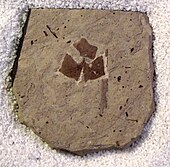 undescribed |
|
unidentified |
Unidentified |
|
Unidentified ostracod shells |
In the initial description of Hat Creek Amber, Poinar et al. make note of a single adult Corydiinae cockroach specimen found in the amber, with a brief commentary on the modern tropical-subtropical distribution of that subfamily and a lack of any native cockroach species in western Canada, but did not give any specific taxonomic identification for the specimen beyond that. [9]
| Family | Genus | species | Sites | Notes | Images |
|---|---|---|---|---|---|
|
Undescribed |
|
Undescribed Diplopterine cockroaches. |
|||
|
Undescribed |
Undescribed [29] |
|
A
blattoidean
cockroach |
 | |
|
Unidentified |
Unidentified [9] |
|
An undescribed corydiine cockroach |
||
|
Unidentified |
Unidentified [20] |
|
Harvester termites |
||
|
Undescribed |
|
||||
|
undescribed |
Undescribed |
Undescribed [29] |
|
Undescribed termites of uncertain affiliation |
 |
The order Coleoptera is divided into four major lineages, Adephaga, Archostemata, Myxophaga, and Polyphaga, with the last group being the most species diverse of the four. Hat Creek amber has provided one fully described beetle species Prionocerites tattriei, [30] which is known from a larval stage specimen first reported by Poinar et al. (1999). [9] The species and genus were the first North American taxon from the family to be described. [30]
| Family | Genus | species | Sites | Notes | Images |
|---|---|---|---|---|---|
| Carabidae |
|
A
sun beetle |
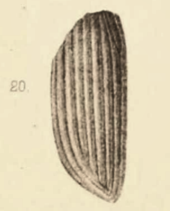 (1890 illustration) | ||
|
Undescribed [27] |
|
A sun beetle relative |
|||
|
Undescribed |
|
Undescribed ground beetles. |
 | ||
|
Undescribed |
Undescribed [29] |
|
|||
|
Undescribed |
Undescribed |
Undescribed [33] |
|
A
caraboid superfamily beetle |
| Family | Genus | species | Sites | Notes | Images |
|---|---|---|---|---|---|
|
Undescribed |
Undescribed [20] |
|
Reticulated beetles |
| Family | Genus | species | Sites | Notes | Images |
|---|---|---|---|---|---|
| Brentidae |
|
 | |||
|
|||||
|
Undescribed |
|
long-horn beetles |
|||
| Chrysomelidae |
|
 (1895 illustration) | |||
|
 (1890 illustration) | ||||
|
Caryobruchus– Speciomerus genus group |
Undescribed [37] |
|
palm beetles, originally identified as cf. tribe Caryopemina. [27] |
||
|
Undescribed |
|
leaf beetles |
|||
|
Undescribed |
|
Undescribed weevils |
|||
|
Undescribed |
Undescribed [20] |
|
Pintail beetles | ||
|
A
Prionocerid beetle |
||||
|
 (1890 illustration) | ||||
|
Undescribed |
Undescribed [20] |
|
Undescribed checkered beetle relatives |
||
|
Undescribed |
Undescribed [27] |
|
Undescribed pleasing fungus beetle relatives. |
||
|
Unidentified |
Undescribed |
Undescribed [33] |
|
A
cucujiform beetle |
| Family | Genus | species | Sites | Notes | Images |
|---|---|---|---|---|---|
| Buprestidae | Buprestis |
|
 (1890 illustration) | ||
|
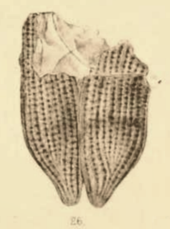 (1890 illustration) | ||||
|
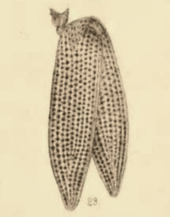 (1890 illustration) | ||||
|
Undescribed |
Undescribed [33] |
|
A
soldier beetle |
||
| Elateridae |
|
A
click beetle |
 (1890 illustration) | ||
|
 (1895 illustration) | ||||
|
undescribed [36] |
|
A click beetle. |
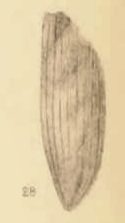 (1890 illustration) | ||
|
Undescribed |
|
undescribed click beetles |
| Family | Genus | species | Sites | Notes | Images |
|---|---|---|---|---|---|
|
Undescribed |
|
||||
|
Undescribed |
Undescribed [20] |
|
Bess beetles | ||
|
 (1890 illustration) | ||||
|
Undescribed |
Undescribed |
|
Undescribed scarab superfamily beetles. |
| Family | Genus | species | Sites | Notes | Images |
|---|---|---|---|---|---|
|
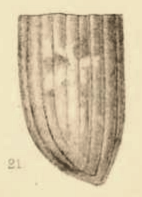 (1890 illustration) | ||||
|
Undescribed |
Undescribed [27] |
|
Undescribed Omaliinae rove beetles. |
||
|
Unidentified |
Undescribed |
Undescribed [33] |
|
A possible
staphylinoid beetle |
Earwig fossils were first noted from republic by paleoentomologist Standley Lewis (1992) in his initial report of the insect diversity at Republic. He noted the fossils to be some of the oldest Eocene demapterans in North America at that time and figured one undescribed specimen consisting of a females abdomen section and cerci. [29] Lewis (1994) tentatively identified the earwigs as members of family Forficulidae based on the shape of the cerci, and illustrated four female fossils, identified as such from the simple straight nature of the cercus. Lewis also suggested two different species were present, based on the differing lengths of the female cerci. [39]
| Family | Genus | species | Sites | Notes | Images |
|---|---|---|---|---|---|
| ? Forficulidae | Undescribed |
"Forficulid species 1" [39] |
|
A forficulid? earwig species with long cerci |
 undescribed |
|
"Forficulid species 2" [39] |
|
A forficulid? earwig species with short cerci |
 undescribed | ||
|
Unidentified [20] |
|
A possible
forficulid earwig |
|||
|
Undescribed |
Undescribed [27] |
|
A forficuline earwig of undetermined placement |
The most common animal fossils at many of the highlands sites are bibionid march flies, [22] with over twenty species from the genera Penthetria and Plecia described. [40] The modern diversity of the family is greatest in lower latitudes, and Plecia only reaches northward to the warm temperate areas of southeastern North America. [22] In the initial description of Hat Creek Amber, Poinar et al. make note of dipteran inclusions found in the deposit but did not give any specific taxonomic identification of taxa or illustrate any specimen. [9]
| Family | Genus | species | Sites | Notes | Images |
|---|---|---|---|---|---|
|
Undescribed |
Undescribed [41] |
|
Trace fossils |
||
|
A
long-legged fly |
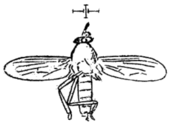 (1910 illustration) | |||
|
Undescribed |
|
dagger flies |
|||
| Pipunculidae |
|
 | |||
|
Indeterminate |
|
Big headed flies, |
|||
|
Undescribed |
Undescribed [33] |
|
snipe flies |
||
|
Unidentified |
|
hover flies or, less likely,
thick headed flies |
The highlands have been noted for the number of Bibionid taxa named in the early work on British Columbian sites. Over 25 unique species have been ascribed to the fossils, with the current count sitting at 22, but doubt has been raised as to the true number of species present and around the generic affinities. The first species was described by Scudder ( 1879 from the Allenby Formation, while the largest number of species were named by Handlirsch ( 1910). Following the practice of the time, both Scudder and Handlirsch placed their species in the genus Penthetria. Harrington Molesworth Anthony Rice ( 1959) reviewed the British Columbian bibionids, notably deeming the majority of species as belonging to Plecia or an undescribed extinct genus and not Penthetria. [40] This placement decision has been questioned however, with Giuseppe Gentilini (1991) asserting the majority of highlands species should be returned to Penthetria. [46] Rice, noted to be a " splitter", [14] also noted the large overlap between the morphology of two species groups and mused that larger collection samples may reveal each group to be single species. He called out in the species discussions the similarities between Plecia avus, P. canadensis, P. dilatata, P. pictipennis, P. pulchra, and P. transitoria, and the similarities between P. curtula, P. nana, P. pulla, and P. reducta. [40]
| Family | Genus | species | Sites | Notes | Images |
|---|---|---|---|---|---|
| Bibionidae |
|
A possible penthetrian march fly |
 | ||
| Penthetria |
|
A
plecian
marchfly |
|||
|
 | ||||
| Plecia |
|
A
plecian
marchfly |
 | ||
|
A
plecian
marchfly |
 | |||
|
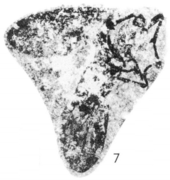 | ||||
|
A
plecian
marchfly |
 | |||
|
A
plecian
marchfly |
 | |||
|
A
plecian
marchfly |
 | |||
|
A
plecian
marchfly |
 | |||
|
 | ||||
|
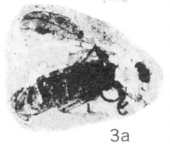 | ||||
|
A
plecian
marchfly |
 | |||
|
A
plecian
marchfly |
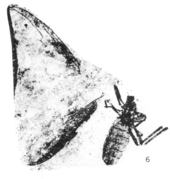 | |||
|
A
plecian
marchfly |
 | |||
|
A
plecian
marchfly |
 | |||
|
A
plecian
marchfly |
 | |||
|
A
plecian
marchfly |
 | |||
|
A
plecian
marchfly |
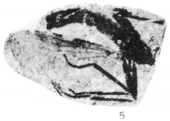 | |||
|
A
plecian
marchfly |
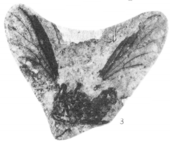 | |||
|
 | ||||
|
Undescribed |
Undescribed [29] |
|
A
march fly |
 undescribed | |
|
Undescribed |
Undescribed [45] |
|
A
bolitophilid fungus gnat |
||
|
Undescribed |
Undescribed [41] |
|
Trace fossils |
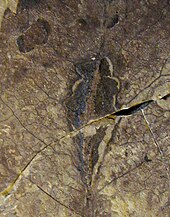 | |
|
Unidentified |
Unidentified [20] |
|
long-bodied craneflies | ||
|
Undescribed |
Undescribed [45] |
|
A possible
keroplatid fungus gnat |
||
|
Unidentified |
Unidentified [20] |
|
Limoniid craneflies |
||
| Mycetophilidae |
Undescribed |
Undescribed [45] |
|
A
gnoristine
fungus gnat |
|
|
Undescribed |
Undescribed [45] |
|
A
leiine
fungus gnat |
||
|
Undescribed |
Undescribed [45] |
|
A
mycetophiline
fungus gnat |
||
|
Undescribed |
Undescribed [45] |
|
A
mycomyiine
fungus gnat |
||
|
Undescribed |
Undescribed [45] |
|
A
sciophiline
fungus gnat |
||
|
Undescribed |
|
fungus gnats unplaced to subfamily |
|||
|
 (1910 illustration) | ||||
|
Unidentified |
|
dark-winged fungus gnats |
|||
| Tipulidae |
|
A cranefly |
 (1910 illustration) | ||
|
Undescribed |
|
crane flies |
 | ||
|
Unidentified |
Unidentified [20] |
|
winter craneflies | ||
|
Unidentified |
Unidentified |
Unidentified [9] |
|
Unidentified dipteran specimens in amber |
Lewis (1992) listed one species of Heptageniidae and three specimens that he did not place to family from Republic. [29] The next year Lewis and Wehr (1993) gave a slightly more detailed description of the specimens again identifying one to Heptageniidae, possibly in the genera Heptagenia or Stenonema. [51] The specimens were later examined by Nina D. Sinitchenkova ( 1999) who described one as a squaregill mayfly and the oldest member of the genus Neoephemera, confirmed the Heptageniidae identification but that it was unidentifiable to genus. The last specimen she confirmed as an ephemeropteran, but unidentifiable below order level. [52]
| Family | Genus | species | Sites | Notes | Images |
|---|---|---|---|---|---|
|
Indeterminate |
|
A
flat headed mayfly |
 | ||
|
Greenwood et al. (2005) briefly discussed the prevalence of Aphid fossils at highlands sites where the taphonomic factors allowed for fine detail preservation such as in the Driftwood shales. [22] Poinar et al. (1999) made note of hemipteran specimens found in Hat Creek Amber but did not give any specific taxonomic identification or illustrate any specimens. [9]
| Family | Genus | species | Sites | Notes | Images |
|---|---|---|---|---|---|
| Aphrophoridae | Aphrophora |
|
An aphrophorine spittle bug hindwing species. |
 (1910 illustration) | |
|
"Indeterminate" [53] |
|
An
aphrophorine
spittle bug |
|||
|
Undescribed [29] |
|
An
aphrophorid spittlebug |
 | ||
|
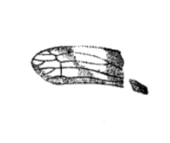 (1895 illustration) | ||||
|
"Indeterminate" [49] |
|
An
aphrophorine
spittle bug |
|||
|
Undescribed [29] |
|
An
aphrophorid spittlebug |
|||
|
 (1895 illustration) | ||||
| Cercopidae | Cercopis |
|
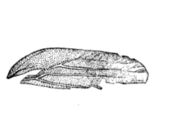 (1895 illustration) | ||
|
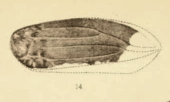 (1890 illustration) | ||||
|
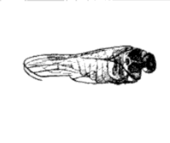 (1895 illustration) | ||||
|
 (1895 illustration) | ||||
|
A
froghopper |
||||
|
 (1895 illustration) | ||||
|
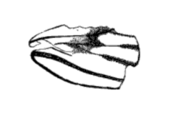 (1895 illustration) | ||||
|
Undescribed |
|
cercopid froghoppers |
 | ||
| Cicadellidae |
|
 (1890 illustration) | |||
|
Undescribed |
|
leafhoppers |
|||
|
Undescribed |
Undescribed [20] |
|
True cicadas |
||
|
Undescribed |
Undescribed [27] |
|
A
cixiid planthopper |
||
|
"Indeterminate" [53] |
|
An
enchophorine
lantern bug |
|||
|
Undescribed |
|
A
ricaniid planthopper |
|||
|
Undescribed |
Undescribed |
Undescribed [29] |
|
A
fulgoroidean hopper |
|
|
Incertae sedis |
|
A hemipteran [32] of uncertain placement |
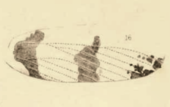 (1890 illustration) |
| Family | Genus | species | Sites | Notes | Images |
|---|---|---|---|---|---|
|
Undescribed |
Undescribed [20] |
|
Relatives of
leaf-footed bugs |
||
|
Undescribed |
Undescribed [27] |
|
A
cydnid burrowing bug |
||
|
A
dinidorid
shield bug |
||||
| Gerridae |
Undescribed [20] |
|
gerrine
water striders |
||
|
|||||
| † Telmatrechus |
|
A
gerrine
water strider |
 (1910 illustration) | ||
|
A
gerrine
water strider |
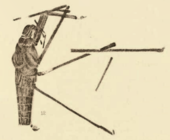 (1890 illustration) | |||
|
Undescribed |
|
A
Shield or stink bug |
 | ||
|
Undescribed |
Undescribed [27] |
|
Pentatomoid shield bugs of uncertain familial placement |
| Family | Genus | species | Sites | Notes | Images |
|---|---|---|---|---|---|
| Aphididae | Undescribed |
|
Aphids |
||
|
Undescribed [41] |
|
Trace fossils |
|||
|
Unidentified |
Unidentified |
Unidentified |
|
aphidoid specimens |
| Family | Genus | species | Sites | Notes | Images |
|---|---|---|---|---|---|
|
Unidentified |
Unidentified |
Unidentified [9] |
|
Hemipterans in amber |
Archibald, Mathewes, & Aase (2023) reported a Titanomyrma species ant queen from Allenby Formation, and noted the range extension for Formiciinae into the highlands, as the subfamily was previously considered a strictly thermophilic ant group. Due to complications arising from preservational distortion during diagenesis, they were unable to determine the correct size of the queen in life. If the distortion was lateral, then compression to bilateral symmetry yielded an adult length of approximately 3.3 cm (1.3 in), placing it the same range as Formicium berryi and F. brodiei, known only from wings, and suggested as possible males. Conversely stretching the fossil to bilateral symmetry results in a larger 5 cm (2.0 in) length estimate, placing it as comparable to queens of T. lubei and T. simillima. [57]
| Family | Genus | species | Sites | Notes | Images |
|---|---|---|---|---|---|
| Cephidae |
|
||||
|
Undescribed |
"Undescribed [4] |
|
|||
| Cimbicidae [4] |
|
||||
| † Leptostigma [58] |
|
||||
|
 | ||||
|
|||||
|
|||||
|
|||||
|
|||||
|
|||||
|
Unidentified |
Unidentified [58] |
|
A cimbicid sawfly of indeterminate subfamily. |
||
|
A parasitic wasp |
||||
| Siricidae |
|
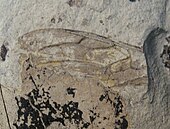 | |||
|
|||||
| Tenthredinidae |
|
 | |||
|
 | ||||
| Undescribed |
Undescribed [4] |
|
Sawflys of the
tenthredinid subfamily
Allantinae |
||
|
Undescribed [4] |
|
Sawflys of the
tenthredinid subfamily
Blennocampinae |
|||
|
Undescribed [4] |
|
Sawflys of the
tenthredinid subfamily
Nematinae |
|||
|
Undescribed [4] |
|
Sawflys of the
tenthredinid subfamily
Tenthredininae |
|||
|
Undescribed [4] |
|
Sawflys of the family
Tenthredinidae, unplaced to subfamily |
| Family | Genus | species | Sites | Notes | Images |
|---|---|---|---|---|---|
| Braconidae |
Undescribed [32] |
|
A Bracon sensu lato species wasp. |
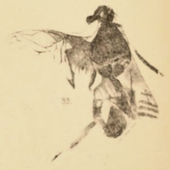 specimen 69&78 (1890 illustration) | |
|
Undescribed |
Undescribed [4] |
|
braconid parasitic wasps unplaced to subfamily |
 | |
|
Undescribed |
Undescribed [41] |
|
Trace fossils |
 | |
|
Cynipidae (?) |
Undescribed |
|
cynipid
Cynipoid gallwasps |
||
|
Undescribed |
Undescribed [4] |
|
diapriid
diaprioid wasps |
||
|
Undescribed |
Undescribed [4] |
|
figitid
cynipoid wasps |
||
|
Undescribed |
Undescribed [4] |
|
helorid
proctotrupoid wasps |
||
| Ichneumonidae |
|
A
xoridine
ichneumon parasitic wasp |
 (1910 illustration) | ||
|
Undescribed |
|
ichneumonid parasitic wasps unplaced to subfamily |
 | ||
|
Undescribed |
Undescribed [4] |
|
ceraphronoid
Megaspilid parasitic wasps |
||
|
Undescribed |
Undescribed [4] |
|
monomachid
diaprioid wasps |
||
|
Undescribed |
Undescribed [4] |
|
peradeniid
proctotrupoid wasps |
||
|
Undescribed |
Undescribed [4] |
|
proctotrupid parasitic wasps |
||
|
Undescribed |
Undescribed [4] |
|
roproniid (sensu lato)
proctotrupoid wasps |
||
| incertae sedis [4] | Undescribed |
Undescribed |
|
Chalcidoid superfamily wasps |
|
|
Undescribed [4] |
|
mymarommatoid microhymenopterans |
| Family | Genus | species | Sites | Notes | Images |
|---|---|---|---|---|---|
|
Undescribed |
Undescribed [4] |
|
Chrysidoid wasps of the
chrysidid subfamily
Chrysidinae |
||
|
Undescribed |
|
pompilid
spider wasps |
|||
|
Undescribed |
|
Scoliid wasps of the subfamily
Archaeoscoliinae |
|||
|
Undescribed |
Undescribed [4] |
|
trigonalid parasitic wasps |
||
|
Undescribed |
Undescribed [4] |
|
Vespid wasps |
| subfamily | Genus | species | Sites | Notes | Images |
|---|---|---|---|---|---|
| Dolichoderinae |
Undescribed [4] |
|
Dolichoderus species ants. [4] Not described to species |
||
|
Undescribed |
Undescribed [4] |
|
Dolichoderine ants. [4] Not described to genus/species |
||
|
Indeterminate [57] |
|
A
formiciine titan ant. |
 | ||
| Formicinae |
|
A
weaver ant |
|||
|
A
weaver ant |
||||
|
Indeterminate |
indeterminate [62] |
|
An
weaver ant tribe worker |
||
|
Undescribed |
Undescribed [4] |
|
Formicinae subfamily ants.
[4] |
||
| Myrmeciinae | † Avitomyrmex |
|
|||
|
|||||
|
|||||
|
|||||
| † Myrmeciites |
|
||||
|
|||||
|
|||||
|
bull dog ants |
 | |||
|
A myrmeciine bulldog ant, first described as a rhopalosomatid wasp. [4] |
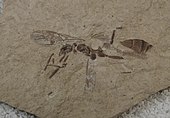 | |||
| † Ypresiomyrma |
|
||||
|
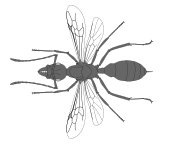 | ||||
|
Undescribed |
Undescribed [4] |
|
Myrmeciinae ants. [4] Not described to species |
||
|
Undescribed |
Undescribed [4] |
|
Myrmicine ants of either Leptothorax or Tetramorium [4] Not described to species |
||
| Incertae sedis |
|
An ant of uncertain subfamily placement [4] |
|||
|
Undescribed |
|
Ants of uncertain subfamily placement. [4] |
 |
| Family | Genus | species | Sites | Notes | Images |
|---|---|---|---|---|---|
| Angarosphecidae | † Eosphecium |
|
A spheciform wasp. |
||
|
Undescribed [4] |
|
Spheciform wasps. |
|||
|
Undescribed |
Undescribed [4] |
|
Spheciform wasps, likely not
Eosphecium. |
||
|
Undescribed |
Undescribed [4] |
|
Apid bees |
||
| Halictidae (?) |
|
A sweat bee of uncertain generic placement |
|||
|
Undescribed |
Undescribed [4] |
|
sweat bees |
||
|
Undescribed |
Undescribed [4] |
|
Megachilid leaf-cutter bee
herbivory
trace fossils on leaves |
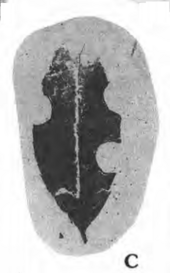 | |
|
Undescribed |
Undescribed [4] |
|
Sphecid (sensu stricto) wasps |
A solitary complete adult female lepidopteran fossil has been recovered, but no full descriptive work has been published on the specimen, aside from a single PhD dissertation. [33] Early examination placed the moth in the family Geometridae, but later work has identified it as the oldest member of the tiger moth subfamily Arctiinae. [67] Two additional isolated wing fossils have been found with one tentatively placed within Noctuidae based on the wing venation and structure, [33] while the second has not been placed beyond order level. [68] Laval mining and hole feeding damage on leaves has been attributed to the families Coleophoridae, Gracillariidae, Heliozelidae, Incurvariidae, and Nepticulidae [41] [69]
| Family | Genus | species | Sites | Notes | Images |
|---|---|---|---|---|---|
|
Trace fossils |
||||
|
Undescribed |
Undescribed [67] |
|
An
arctiine
tiger moth |
 undescribed | |
|
Undescribed |
|
Trace fossils |
|||
|
Undescribed |
|
Trace fossils |
|||
|
Undescribed [41] |
|
Trace fossils |
|||
|
Undescribed [41] |
|
Trace fossils |
|||
|
Undescribed [41] |
|
Trace fossils |
|||
|
Undescribed |
Undescribed [33] |
|
A possible
owlet moth |
||
|
Undescribed |
Undescribed |
Undescribed [68] |
|
A lepidopteran forewing |
| Family | Genus | species | Sites | Notes | Images |
|---|---|---|---|---|---|
|
Undescribed |
Undescribed [20] |
|
hangingfly specimens |
||
| † Cimbrophlebiidae | † Cimbrophlebia |
|
 | ||
|
|||||
|
|||||
|
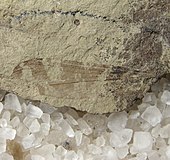 | ||||
| † Dinopanorpidae | † Dinokanaga |
|
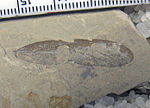 | ||
|
 | ||||
|
|||||
|
|||||
|
|||||
|
|||||
| Eomeropidae | † Eomerope |
|
|||
|
|||||
|
|||||
| † Eorpidae | † Eorpa |
|
 | ||
|
|||||
|
 | ||||
|
† Holcorpa |
|
||||
|
Undescribed |
Undescribed [74] |
|
Undescribed
common scorpionflies |
| Family | Genus | species | Sites | Notes | Images |
|---|---|---|---|---|---|
|
|||||
| Chrysopidae | † Adamsochrysa |
|
|||
|
 | ||||
| † Archaeochrysa |
|
||||
|
|||||
|
|||||
|
|||||
|
|||||
|
|||||
|
A
corydasialid
lacewing |
||||
| Hemerobiidae |
|
A
hemerobiid lacewing |
|||
|
|||||
|
Undescribed |
Undescribed [20] |
|
Brown lacewing specimens | ||
| Ithonidae |
|
An Ithonid group moth lacewing |
 | ||
| † Palaeopsychops |
|
A polystechotid group
moth lacewing |
|||
|
A polystechotid group moth lacewing |
||||
|
A polystechotid group moth lacewing |
 | |||
|
A polystechotid group moth lacewing |
||||
|
A polystechotid group moth lacewing |
 | |||
| † Polystoechotites |
|
A polystechotid group moth lacewing |
 | ||
|
A polystechotid group moth lacewing |
 | |||
|
A polystechotid group moth lacewing |
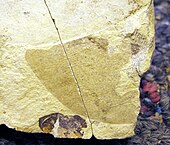 | |||
|
A Polystoechotid-group
moth lacewing
[86] |
 (1895 illustration) | |||
|
Undescribed |
Undescribed [20] |
|
Polystoechotid-group
moth lacewings |
||
| Nymphidae |
|
A split-footed lacewing, possibly sister species to † Nymphes georgei | |||
|
A
split-footed lacewing |
 | |||
| Osmylidae | † Osmylidia |
|
|||
|
|||||
|
Indeterminate [90] |
|
A
protosmyline
osmylid lacewing, |
|||
|
Undescribed |
Undescribed [20] |
|
osmylid lacewing specimens |
||
|
A possible psychopsid lacewing |
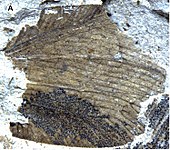 | |||
|
Undescribed |
Undescribed |
Undescribed [20] |
|
Members of an undescribed neuropteran family |
Trace fossil evidence of damselflies has been recorded from oviposition scars on various leaves from the Klondike Mountain Formation that have been placed in the ichnogenus Paleoovoidus. Lewis and Carrol (1991) originally identified the damage on an Alnus parvifolia leaf as caused by leaf beetles of the genus Altica. This was later questioned by Conrad Labandeira who noted the scar patterns did not match modern Altica egg laying behaviour.
| Family | Genus | species | Sites | Notes | Images |
|---|---|---|---|---|---|
| Aeshnidae |
|
 | |||
|
† Eoshna |
|
||||
|
 | ||||
| † Ypshna |
|
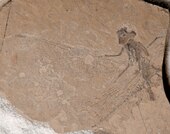 | |||
|
|||||
| † Dysagrionidae |
|
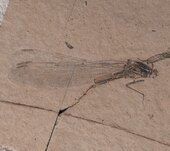 | |||
|
 | ||||
| † Okanagrion |
|
||||
|
|||||
|
 | ||||
|
 | ||||
|
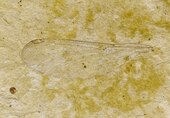 | ||||
|
|||||
|
 | ||||
|
 | ||||
| † Okanopteryx |
|
||||
|
 | ||||
|
|||||
|
 | ||||
|
† Allenbya |
|
A possible
Dysagrionidae odonate. |
 | ||
|
A
gossamerwing
damselfly. |
 | |||
|
|||||
|
A possible cephalozygopteran odonate |
 |
| Family | Genus | species | Sites | Notes | Images |
|---|---|---|---|---|---|
|
Unidentified |
Unidentified [20] |
|
Catanopine
short-horned grasshopper specimens |
||
|
Unidentified |
Unidentified [20] |
|
Possible
leaf-rolling cricket specimens |
||
|
 (1910 illustration) | ||||
| † Palaeorehniidae |
|
 | |||
|
A
palaeorehniid
ensiferan. |
||||
|
Unidentified |
Unidentified [20] |
|
grig specimens |
||
|
Unidentified |
Unidentified [20] |
|
katydid specimens |
| Family | Genus | species | Sites | Notes | Images |
|---|---|---|---|---|---|
|
| Family | Genus | species | Sites | Notes | Images |
|---|---|---|---|---|---|
|
Unidentified |
Unidentified |
Unidentified [20] |
|
stonefly specimens |
The only reported Psocodea fossils from the highlands are known from Hat Creek amber. They were mentioned, as "Psocoptera", in passing by Poinar et al. (1999) who did not give any finer taxonomic detail or illustrate any specimens. [9]
| Family | Genus | species | Sites | Notes | Images |
|---|---|---|---|---|---|
|
Unidentified |
Unidentified |
Unidentified [9] |
|
specimens in amber |
| Family | Genus | species | Sites | Notes | Images |
|---|---|---|---|---|---|
|
|||||
| Raphidiidae |
|
 | |||
| † Megaraphidia |
|
||||
|
|||||
|
|||||
|
Poinar et al. (1999) illustrated a Thrips specimen in Hat Creek amber and noted the presence of the order in the fossils they examined, however they did not provide any finer taxonomic details on the affinities of the fossils. [9]
| Family | Genus | species | Sites | Notes | Images |
|---|---|---|---|---|---|
|
Unidentified |
Unidentified |
Unidentified [9] |
|
specimens in amber |
Trichopterans are known mainly from laraval cases and occasional isolated wings. [27]
| Family | Genus | species | Sites | Notes | Images |
|---|---|---|---|---|---|
|
Unidentified |
unidentified [29] |
|
northern caddisflies |
||
|
Unidentified |
|
giant caddisflies |
 | ||
|
Unidentified |
Unidentified |
|
Isolated wings and larval cases |
The first fish to be described from the Okanagan Highlands were recovered from Allenby Formation shales and subsequently studied by Edward Drinker Cope who named Amyzon brevipinne in 1894. The next descriptive work for a fish came in 1916 with the naming of "Lucious" rosei by Louis Hussakof from Tranquille Formation fossils collected at "Red point" on Kamloops Lake in 1914. [99] "Lucious" rosei was redescribed in 1966 by Ted Cavander, who moved the species to a new genus Eohiodon placed into the mooneye family Hiodontidae. The largest body of work for fish of the Highlands was by Mark Wilson (1977) who published a monograph detailing the Canadian highlands formations fish fauna, naming four new species in three new genera, plus redescribing both "Amyzon" brevipinne and "Eohiodon" rosei. The monograph added the families Salmonidae with Eosalmo driftwoodensis, Libotoniidae with Libotonius blakeburnensis, and Moronidae with Priscacara aquilonia. [24] A year later the first species from the Republic area, "Eohiodon" woodruffi was described by Wilson, [100] and the second Republic species Libotonius pearsoni followed in 1979. [101] in 1982 the final new fish species named from the highlands, Amia hesperia, was described, being initially placed by Wilson in the modern bowfin genus Amia. [102] This placement was later questioned by Lance Grande and William Bemis (1998), who noted that due to preservational orientation of the A. hesperia holotype, generic placement of the species was problematic. Phylogenetic analysis of Amiidae fossils by Grande and Bemis found the fossil as a member of the amiinae subfamily, but with key mouth anatomy missing, were unable to determine if Amia or the extinct genus Cyclurus was correct. [103] In 2021 fossils of "Amyzon" brevipinne were redescribed by Juan Liu based on the holotype and additional fossils from the Allenby Formation, and based on the anatomical differences between the species and the type species of Amyzon mentale determined that the Princeton fossils were part of a different genus. As such Liu moved the species to the new genus Wilsonium. [104]
| Family | Genus | species | Sites | Notes | Images |
|---|---|---|---|---|---|
| Amiidae | Amia? |
|
|||
|
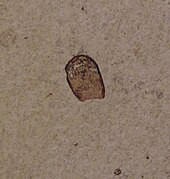 | ||||
| Catostomidae | † Amyzon |
|
A sucker |
||
|
A
sucker |
 | |||
| † Wilsonium |
|
A
catostomid sucker, |
|||
|
A
catostomid sucker, |
||||
| Hiodontidae | Hiodon |
|
A
mooneye, first described as Lucious rosei (
1916), |
||
|
A
mooneye, first described as Eohiodon woodruffi.
[100] |
 | |||
|
Unidentified [28] |
|
A
mooneye jaw. |
|||
| † Libotoniidae | † Libotonius |
|
A sand roller relative. |
||
|
A sand roller relative. |
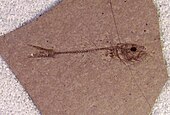 | |||
|
|||||
| Salmonidae | † Eosalmo |
|
A basal Salmon |
 | |
|
A basal
Salmon |
The only reptile fossils known from the Okanagan highlands come from the Allenby Formation. A soft-shelled turtle is known from the "Ashnola shales" unit and unidentified turtle bone are known from the interbedded Princeton Chert. The soft shelled turtle was first discovered by James Basinger from dark shale layers above the chert and reported by Wilson (1982). [102] The unidentified turtle bones were found preserved within the chert layers and first reported by Stockey and Pigg (1994). [109] In his 1995 Masters thesis, G. Guthrie listed an isolated tooth from the Quilchena site as from a crocodile, which would have been the only instance of a crocodylian in the highlands. [28] The taxonomic affinity was later revised after further examination and Mathewes et al. (2016) listed the specimen as an unidentified fish tooth. [110]
| Family | Genus | species | Sites | Notes | Images |
|---|---|---|---|---|---|
|
Cf. Apalone or Aspideretes |
|
A
soft shelled turtle |
|||
|
Undescribed |
Undescribed |
undescribed [109] |
|
A
turtle, |
A small avifauna is known from the Okanagan Highlands, but due to the incomplete nature of the fossils, placement of studied specimens has been tentative at best. [112] Gerald Mayr et al. (2019) published an initial overview of the fossils with descriptions and commentary of the material, noting the taxa identified were all previously unknown to Northwestern North American Eocene sites. Despite the tentative nature of the fossil identifications, the Highlands sites are the richest Paleogene avifauna described from Canada. Mayr et al. (2019) posited that the fossils likely represent the more common species in the avifauna of the Highlands, but at the same time, include taxa that are considered rare or absent in the most studied avifaunas from the same time frame. [112] Additional evidence of birds at some sites consists of preserved egested bird pellets, which are composed of randomly grouped fish bone clumps, occasionally including multiple fish or insects. [28]
Isolated feathers are also known from several of the sites and have not described in detail. [112]
| Order/Clade | Family | Material | Sites | Notes | Images |
|---|---|---|---|---|---|
|
indeterminate |
partial skeleton |
|
a large possible
Coliiform, |
||
|
indeterminate |
left wing and partial right wing, with feathers |
|
a possible
gaviiform, |
||
|
articulated postcranial skeleton |
|
A possible
songziid bird, |
|||
|
complete, but poorly preserved, skeleton |
|
a possible
zygodactylid, |
|||
|
indeterminate [112] |
indeterminate |
partial skeletons |
|
partial skeletons missing details for identification. |
 McAbee site |
|
indeterminate |
feathers |
|
isolated feathers |
 |
Eocene mammals are exclusively known from sites in, or possibly in, the Okanagan Highlands. The earliest reported mammals were of teeth from the Princeton area in 1935, with one of the fossils subsequently being "lost". More recent work in 2014 and 2017 on fossils from Driftwood and Princeton have expanded the mammal families to three, possibly four, and an undescribed Quilchena fossil being identified as a " lipotyphla". [113] [5] The record of Brontotheriidae is uncertain due to the split opinion regarding inclusion of the Quesnel area sediments as part of the Highlands. [5] [4] [2]
| Family | Genus | species | Sites | Notes | Images |
|---|---|---|---|---|---|
| Erinaceidae |
|
A hedgehog and moonrat relative |
|||
|
An unidentified hedgehog relative, |
||||
| Esthonychidae | † Trogosus |
|
A tillodont species |
||
|
An indeterminate
tillodont |
||||
|
indeterminate [113] |
|
||||
|
undescribed |
undescribed |
undescribed [5] |
|
A " lipotyphlan" |
Pellets of fish bone and other animal material which were likely eaten by larger predators and then regurgitated have been reported from the Quilchena and Republic sites. These traces, called regurgitalites, have so far been understudied, with only a few passing mentions in Okanagan highlands literature. [112]
If the Quesnel sites are included as part of the Greater Okanagan Highlands per Archibald et al. (2018) the fauna of the region is expanded by a number of insect taxa, an additional arachnid, and a brontothere.
| Family | Genus | species | Sites | Notes | Images |
|---|---|---|---|---|---|
|
An
orb-web spider
egg sack. |
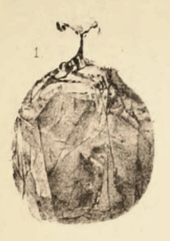 (1890 illustration |
| Family | Genus | species | Sites | Notes | Images |
|---|---|---|---|---|---|
|
 (1890 illustration) |
| Family | Genus | species | Sites | Notes | Images |
|---|---|---|---|---|---|
|
An
anthomyiid fly. |
 (1890 illustration) | |||
|
An
anthomyiid fly. |
 (1890 illustration) | |||
|
Undescribed |
Undescribed [32] |
|
An undescribed robber fly |
||
|
Undescribed [117] |
|
An undescribed long-legged fly. |
 specimen 14651 (1890 illustration) | ||
|
 (1890 illustration) | ||||
|
" Lonchaea" |
|
A
lauxaniid fly. First placed in
Lonchaea
[117] |
 (1890 illustration) | ||
|
A fungus gnat. |
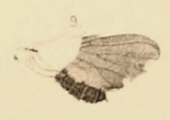 (1890 illustration) | |||
|
 (1890 illustration) | ||||
|
 (1890 illustration) | ||||
|
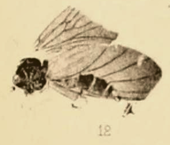 (1890 illustration) | ||||
|
 (1890 illustration) | ||||
|
 (1890 illustration) | ||||
|
A marsh fly. |
 (1890 illustration) | |||
|
 (1890 illustration) |
| Family | Genus | species | Sites | Notes | Images |
|---|---|---|---|---|---|
|
A
shield bug |
 (1890 illustration) | |||
|
Incertae sedis |
|
An
aphidomorph of uncertain placement |
 (1890 illustration) | ||
|
incertae sedis |
|
An
aphidoid of uncertain placement |
 (1890 illustration) |
| Family | Genus | species | Sites | Notes | Images |
|---|---|---|---|---|---|
|
A myrmicine ant, possibly nomen dubium. [119] |
 (1890 illustration) | |||
|
An ant of uncertain placement. |
 (1890 illustration) | |||
|
A
dolichoderine ant |
 (1890 illustration) | |||
|
A formicine ant |
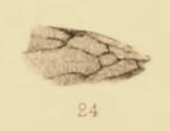 (1890 illustration) | |||
|
 (1890 illustration) | ||||
|
 (1890 illustration) | ||||
|
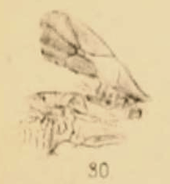 (1890 illustration) |
| Family | Genus | species | Sites | Notes | Images |
|---|---|---|---|---|---|
|
A hemerobiid lacewing of uncertain subfamily placement |
 (1890 illustration) |
| Family | Genus | species | Sites | Notes | Images |
|---|---|---|---|---|---|
|
indeterminate |
indeterminate [121] |
|
A
Brontotheriina subtribe Brontothere |
- ^ a b c Moss, P.; Greenwood, D.; Archibald, S. (2005). "Regional and local vegetation community dynamics of the Eocene Okanagan Highlands (British Columbia – Washington State) from palynology". Canadian Journal of Earth Sciences. 42 (2): 187–204. Bibcode: 2005CaJES..42..187M. doi: 10.1139/E04-095.
- ^ a b c d Archibald, S. B.; Cannings, R. A. (2022). "The first Odonata from the early Eocene Allenby Formation of the Okanagan Highlands, British Columbia, Canada (Anisoptera, Aeshnidae and cf. Cephalozygoptera, Dysagrionidae)". The Canadian Entomologist. 154 (1): e29. doi: 10.4039/tce.2022.16. S2CID 250035713.
- ^ Höy, T.; Friedman, R.; Gabites, J. Paleogene Penticton Group, Boundary area, Southern British Columbia (Parts of NTS 082E): Geochronology and Implications for Precious Metal Mineralization (PDF) (Report). Geoscience BC Summary of Activities 2020: Minerals, Geoscience BC, Report 2021-01. Geoscience BC. pp. 55–66.
- ^ a b c d e f g h i j k l m n o p q r s t u v w x y z aa ab ac ad ae af ag ah ai aj ak al am an ao ap aq ar as at au av aw ax ay az ba bb bc bd be bf bg bh bi bj bk bl bm bn bo bp bq br bs bt bu bv bw bx Archibald, S. B.; Rasnitsyn, A. P.; Brothers, D. J.; Mathewes, R. W. (2018). "Modernisation of the Hymenoptera: ants, bees, wasps, and sawflies of the early Eocene Okanagan Highlands of western North America". The Canadian Entomologist. 150 (2): 205–257. doi: 10.4039/tce.2017.59. ISSN 0008-347X. S2CID 90017208.
- ^ a b c d e f g Eberle, J.J.; Greenwood, D.R. (2017). "An Eocene brontothere and tillodonts (Mammalia) from British Columbia, and their paleoenvironments". Canadian Journal of Earth Sciences. 54 (9): 981–992. Bibcode: 2017CaJES..54..981E. doi: 10.1139/cjes-2017-0061. hdl: 1807/77901.
- ^ a b c Archibald, S.; Greenwood, D.; Smith, R.; Mathewes, R.; Basinger, J. (2011). "Great Canadian Lagerstätten 1. Early Eocene Lagerstätten of the Okanagan Highlands (British Columbia and Washington State)". Geoscience Canada. 38 (4): 155–164.
- ^ Feldmann, R.; Schweitzer, C.; Leahy, J. (2011). "New Eocene crayfish from the McAbee Beds in British Columbia: First record of Parastacoidea in the Northern Hemisphere". Journal of Crustacean Biology. 31 (2): 320–331. doi: 10.1651/10-3399.1.
- ^ a b Archibald, S. B.; Makarkin, V. N. (2006). "Tertiary giant lacewings (Neuroptera: Polystoechotidae): revision and description of new taxa from western North America and Denmark" (PDF). Journal of Systematic Palaeontology. 4 (2): 119–155. doi: 10.1017/S1477201906001817. S2CID 55970660.
- ^ a b c d e f g h i j k l m n o p q Poinar, G.; Archibald, S.; Brown, A. (1999). "New amber deposit provides evidence of early Paleogene extinctions, paleoclimates, and past distributions". The Canadian Entomologist. 131 (2): 171–177. doi: 10.4039/Ent131171-2. S2CID 85718312.
- ^ a b Grimaldi, D.; Sunderlin, D.; Aaroe, G.; Dempsky, M.; Parker, N.; Tillery, G.; White, J.; Barden, P.; Nascimbene, P.; Williams, C. (2018). "Biological inclusions in amber from the Paleogene Chickaloon Formation of Alaska". American Museum Novitates (3908): 1–37.
- ^ Pigg, K. B.; DeVore, M. L. (2016). "A review of the plants of the Princeton chert (Eocene, British Columbia, Canada)". Botany. 94 (9): 661–681. doi: 10.1139/cjb-2016-0079. hdl: 1807/73571.
- ^ a b c McKellar, R. C.; Wolfe, A. P.; Penney, D. (2010). "Chapter 9: Canadian amber". In Penney, D. (ed.). Biodiversity of Fossils in Amber from the Major World Deposits. Siri Scientific Press. pp. 149–166. ISBN 978-0-9558636-4-6.
- ^ a b c Archibald, S.B.; Makarkin, V.N. (2004). "New genus of minute Berothidae (Neuroptera) from Early Eocene amber of British Columbia". The Canadian Entomologist. 136 (1): 61–76. CiteSeerX 10.1.1.552.2285. doi: 10.4039/n03-043. S2CID 36459014.
- ^ a b c d Wilson, M. (1977). "New records of insect families from the freshwater Middle Eocene of British Columbia". Canadian Journal of Earth Sciences. 14 (5): 1139–1155. Bibcode: 1977CaJES..14.1139W. doi: 10.1139/e77-104.
- ^ Wilson, M. (1978). "Paleogene insect faunas of western North America". Quaestiones Entomologicae. 14 (1): 13–34.
- ^ a b c d e f g h Russell, L. S. (1957). "Mollusca from the Tertiary of Princeton, British Columbia". National Museum of Canada Bulletin. 147: 84–95.
- ^ a b c d e Wilson, M. (1987). "Predation as a source of fish fossils in Eocene lake sediments". PALAIOS. 2 (5): 497–500. Bibcode: 1987Palai...2..497W. doi: 10.2307/3514620. JSTOR 3514620.
- ^ a b Pigg, K. B.; Bryan, F. A.; DeVore, M. L. (2018). "Paleoallium billgenseli gen. et sp. nov.: fossil monocot remains from the latest Early Eocene Republic Flora, northeastern Washington State, USA". International Journal of Plant Sciences. 179 (6): 477–486. doi: 10.1086/697898. S2CID 91055581.
- ^ a b Selden, P.A.; Penney, D. (2009). "A fossil spider (Araneae: Pisauridae) of Eocene age from Horsefly, British Columbia, Canada". Contributions to Natural History. 12: 1269–1282.
- ^ a b c d e f g h i j k l m n o p q r s t u v w x y z aa ab ac ad ae af ag ah ai aj ak al am an ao ap aq ar as Wilson, M.V.H. 2009. McAbee Fossil Site Assessment Report. 60 pp. Online PDF. Accessed 17 May 2021.
- ^ a b Wehr, W. "Middle Eocene insects and plants of the Okanogan Highlands". In Martin, J. (ed.). Contributions to the Paleontology and Geology of the West Coast. Seattle, Washington: University of Washington Press. pp. 99–109.
- ^ a b c d e f g h i Greenwood, D.; Archibald, S.; Mathewes, R.; Moss, P. (2005). "Fossil biotas from the Okanagan Highlands, southern British Columbia and northeastern Washington State: climates and ecosystems across an Eocene landscape". Canadian Journal of Earth Sciences. 42 (2): 167–185. Bibcode: 2005CaJES..42..167G. doi: 10.1139/e04-100.
- ^ a b Labandeira, C.C. (2021). "Ecology and evolution of gall-inducing arthropods: The pattern from the terrestrial fossil record". Frontiers in Ecology and Evolution. 9. doi: 10.3389/fevo.2021.632449.
- ^ a b c d e f g h i j k l m n o p q r s t u Wilson, MVH (1977). "Middle Eocene freshwater fishes from British Columbia". Life Sciences Contributions, Royal Ontario Museum. 113: 1–66.
- ^ a b c Wehr, W. C.; Barksdale, L. L. (1995). "Implications of middle Eocene feathers and crayfish from Republic, Washington". Washington Geology. 23 (4): 6–10.
- ^ a b c Feldmann, R.; Schweitzer, C.; Leahy, J. (2011). "New Eocene crayfish from the McAbee Beds in British Columbia: First record of Parastacoidea in the Northern Hemisphere". Journal of Crustacean Biology. 31 (2): 320–331. doi: 10.1651/10-3399.1.
- ^ a b c d e f g h i j k l m n o p q r s t u v w x y z aa ab ac ad Archibald, S.B.; Mathewes, R.W. (2000). "Early Eocene insects from Quilchena, British Columbia, and their paleoclimatic implications" (PDF). Canadian Journal of Zoology. 78 (8): 1441–1462. doi: 10.1139/cjz-78-8-1441.
- ^ a b c d e f g h Guthrie, G. H. (1995). A high resolution palaeoecological analysis of an Eocene fossil locality from Quilchena, British Columbia (MA thesis). Simon Fraser University.
- ^ a b c d e f g h i j k l m n o p q r s t u v w Lewis, S.E. (1992). "Insects of the Klondike Mountain Formation, Republic, Washington". Washington Geology. 20 (3): 15–19.
- ^ a b c Lawrence, J.F.; Archibald, S.B.; Ślipiński, A. (2008). "A new species of Prionoceridae (Coleoptera: Cleroidea) from the Eocene of British Columbia, Canada". Annales Zoologici. 58 (4): 689–693. doi: 10.3161/000345408X396620. S2CID 55873252.
- ^ Bousquet, Y (2012). "Catalogue of Geadephaga (Coleoptera, Adephaga) of America, north of Mexico". ZooKeys (245): 1570. doi: 10.3897/zookeys.245.3416. PMC 3577090. PMID 23431087.
- ^ a b c d e f g h i j k l m n o p q Scudder, S. H (1879). "Appendix A. The fossil insects collected in 1877, by Mr. G.M. Dawson, in the interior of British Columbia". Geological Survey of Canada, Report of Progress for. 1877–1878: 175–185.
- ^ a b c d e f g h i j k l m n o p q r s t u v w Douglas, S.; Stockey, R. (1996). "Insect fossils in middle Eocene deposits from British Columbia and Washington State: faunal diversity and geological range extensions". Canadian Journal of Zoology. 74 (6): 1140–1157.
- ^ Legalov, A. A. (2013). "New and little known weevils (Coleoptera: Curculionoidea) from the Paleogene and Neogene". Historical Biology: An International Journal of Paleobiology. 25 (1): 59–80. doi: 10.1080/08912963.2012.692681. S2CID 86584002.
- ^ Legalov, A. A. (2015). "Fossil Mesozoic and Cenozoic weevils (Coleoptera, Obrienioidea, Curculionoidea)". Paleontological Journal. 49 (13): 1442–1513. doi: 10.1134/S0031030115130067. S2CID 87912009.
- ^ a b c d Scudder, S. H (1895). "Canadian fossil insects, myriapods and arachnids, Vol II. The Coleoptera hitherto found fossil in Canada". Geological Survey of Canada Contributions to Canadian Palaeontology. 2: 5–26.
- ^ Archibald, S.B.; Morse, G.; Greenwood, D.R.; Mathewes, R.W. (2014). "Fossil palm beetles refine upland winter temperatures in the Early Eocene Climatic Optimum". Proceedings of the National Academy of Sciences. 111 (22): 8095–8100. Bibcode: 2014PNAS..111.8095A. doi: 10.1073/pnas.1323269111. PMC 4050627. PMID 24821798.
- ^ a b Kundrata, R.; Packova, G.; Prosvirov, A.; Hoffmannova, J. (2021). "The fossil record of Elateridae (Coleoptera: Elateroidea): Described species, current problems and future prospects". Insects. 12 (286): 20. doi: 10.3390/insects12040286. PMC 8064311. PMID 33805978.
- ^ a b c Lewis, S.E. (1994). "Fossil earwigs (Dermaptera) from the Klondike Mountain Formation (middle Eocene) of Republic, Washington". Washington Geology. 22 (1): 39–40.
- ^ a b c d e f g h i j k l m n o p q r s t u v w x y z aa ab ac ad ae af ag ah ai aj ak al am an ao ap aq ar as at au av aw Rice, H. M. A (1959). "Fossil Bibionidae (Diptera) from British Columbia". Geological Survey of Canada Bulletin. 55: 1–36.
- ^ a b c d e f g h i j k Labandeira, C. C. (2002). "Paleobiology of middle Eocene plant-insect associations from the Pacific Northwest: a preliminary report". Rocky Mountain Geology. 37 (1): 31–59. doi: 10.2113/gsrocky.37.1.31.
- ^ a b c Evenhuis (1994). Catalogue of the Fossil Flies of the World (Insecta: Diptera). Backhuys Publishers. pp. 1–600.
- ^ a b c d e f g h i j k l m n o p q r s t Handlirsch, A. (1910). "Canadian fossil Insects. 5. Insects from the Tertiary lake deposits of the southern interior of British Columbia, collected by Mr. Lawrence M. Lambe". Contributions to Canadian Palaeontology. 2 (3): 93–129.
- ^ a b Archibald, SB; Kehlmaier, C; Mathewes, RW (2014). "Early Eocene big headed flies (Diptera: Pipunculidae) from the Okanagan Highlands, western North America". The Canadian Entomologist. 146 (4): 429–443. doi: 10.4039/tce.2013.79. S2CID 55738600.
- ^ a b c d e f g h i Archibald, S.B.; Greenwood, D.R.; Mathewes, R.W. (2013). "Seasonality, montane beta diversity, and Eocene insects: Testing Janzen's dispersal hypothesis in an equable world". Palaeogeography, Palaeoclimatology, Palaeoecology. 371: 1–8. Bibcode: 2013PPP...371....1A. doi: 10.1016/j.palaeo.2012.10.043.
- ^ Gentilini, G. (1991). "Bibionidae (Diptera: Nematocera) from the Upper Miocene of Monte Castellaro (Marche, Central Italy)". Bolletino del Museo Civico di Storia Naturale, Verona. 15: 425–446.
- ^ Scuddar, S. H. (1892). "Some Insects of special interest from Florissant, Colorado and other points in the Tertiaries of Colorado and Utah". Bulletin of the United States Geological Survey. 93: 1–25.
- ^ Fitzgerald, S. J. (1999). "A new species of Plecia from the Green River Formation and new combinations of fossil Bibionidae (Diptera)". Great Basin Naturalist. 59: 182–187. doi: 10.5962/bhl.part.15821.
- ^ a b c d e f g Scudder, S. H. (1890). "The Tertiary insects of North America". United States Geological Survey of the Territories, Washington: 615. ISBN 9780665263149.
- ^ Handlirsch, A. (1909). "Zur Phylogenie und Flügelmorphologie der Ptychopteriden (Dipteren)". Annalen des Kaiserlich-Königlichen Naturhistorischen Hofmuseums. 23: 263–272.
- ^ Lewis, S. E.; Wehr, W. (1993). "Fossil mayflies from Republic, Washington" (PDF). Washington Geology. 21 (1): 35–37.
- ^ a b c Sinitchenkova, N. D. (1999). "A new mayfly species of the extant genus Neoephemera from the Eocene of North America (Insecta: Ephemerida=Ephemeroptera)" (PDF). Paleontological Journal. 33 (4): 403–405. Archived from the original (PDF) on 2011-09-30.
- ^ a b c d e f g h i Scudder, S. H (1895). "Canadian fossil insects, myriapods and arachnids, Vol I. The Tertiary Hemiptera of British Columbia". Geological Survey of Canada Contributions to Canadian Palaeontology. 2: 5–26.
- ^ Szwedo, J.; Lefebvre, F. (2004). Fossil planthoppers of the world (Hemiptera: Fulgoromorpha). An annotated catalogue with notes on Hemiptera classification. Warszawa: Studio, 1. pp. 48–49. ISBN 83-912236-8-X.
- ^ Andersen, N.M. (1998). "Water striders from the Paleogene of Denmark and review of fossil record and evolution of semi aquatic bugs (Hemiptera Gerromorpha)". Biologiske Skrifter. 50: 1–157.
- ^ a b c Damgaard, J. (2008). "Evolution of the semi-aquatic bugs (Hemiptera: Heteroptera: Gerromorpha) with a re-interpretation of the fossil record". Acta Entomologica Musei Nationalis Pragae. 48: 251–268.
- ^ a b Archibald, S.; Mathewes, R.; Aase, A. (2023). "Eocene giant ants, Arctic intercontinental dispersal, and hyperthermals revisited: discovery of fossil Titanomyrma (Hymenoptera: Formicidae: Formiciinae) in the cool uplands of British Columbia, Canada". The Canadian Entomologist. 155 (e6).
- ^ a b c d e f g h i j k Archibald, S. B.; Rasnitsyn, A. P. (2023). "Cimbicidae (Hymenoptera, "Symphyta") in the Paleogene: revision, the new subfamily Cenocimbicinae, and new taxa from the Eocene Okanagan Highlands". Zootaxa. 5278 (1): 1–38. doi: 10.11646/zootaxa.5278.1.1.
- ^ Archibald, S.B.; Rasnitsyn, A.P. (2015). "New early Eocene Siricomorpha (Hymenoptera: Symphyta: Pamphiliidae, Siricidae, Cephidae) from the Okanagan Highlands, western North America". The Canadian Entomologist. 148 (2): 209–228. doi: 10.4039/tce.2015.55. S2CID 85743832.
- ^ Archibald, S. B.; Rasnitsyn, A. P. (2022). "The early Eocene Eourocerus anguliterreus gen. et sp. nov (Hymenoptera, Siricidae) from Republic, Washington". Zootaxa. 5105 (2): 289–295. doi: 10.11646/zootaxa.5105.2.8. PMID 35391300. S2CID 247240762.
- ^ a b Rice, H.M.A. (1968). "Two Tertiary sawflies, (Hymenoptera - Tenthredinidae), from British Columbia". Geological Survey of Canada. 67 (59): 1–21.
- ^ a b c Archibald, S. B.; Mathewes, R. W.; Perfilieva, K. S. (2024). "Fossil weaver ants (Hymenoptera, Formicidae, Oecophyllini) of the early Eocene Okanagan Highlands of far-western North America". The Canadian Entomologist. 156. e2. doi: 10.4039/tce.2023.27.
- ^ a b Dlussky, G. M.; Rasnitsyn, A. P. (1999). "Two new species of aculeate hymenopterans (Vespida=Hymenoptera) from the Middle Eocene of the United States". Paleontological Journal. 33: 546–549.
- ^ Perfilieva, K. S.; Dubovikoff, D. A.; Dlussky, G. M. (2017). "Miocene ants (Hymenoptera, Formicidae) from Crimea". Paleontological Journal. 51 (4): 391–401. doi: 10.1134/S0031030117040098. S2CID 90536477.
- ^ a b c d e f g h i j Archibald, S.B.; Cover, S. P.; Moreau, C. S. (2006). "Bulldog Ants of the Eocene Okanagan Highlands and History of the Subfamily (Hymenoptera: Formicidae: Myrmeciinae)" (PDF). Annals of the Entomological Society of America. 99 (3): 487–523. doi: 10.1603/0013-8746(2006)99[487:BAOTEO]2.0.CO;2.
- ^ Dlussky, G. M.; Rasnitsyn, A. P. (2003). "Ants (Hymenoptera: Formicidae) of Formation Green River and some other Middle Eocene deposits of North America". Russian Entomological Journal. 11 (4): 411–436.
- ^ a b Toussaint, E. F.; Condamine, F. L.; Kergoat, G. J.; Capdevielle-Dulac, C.; Barbut, J.; Silvain, J. F.; Le Ru, B. P. (2012). "Palaeoenvironmental shifts drove the adaptive radiation of a noctuid stemborer tribe (Lepidoptera, Noctuidae, Apameini) in the Miocene". PLOS ONE. 7 (7): e41377. Bibcode: 2012PLoSO...741377T. doi: 10.1371/journal.pone.0041377. PMC 3409182. PMID 22859979.
- ^ a b c Sohn, Jae-Cheon; Labandeira, Conrad; Davis, Donald; Mitter, Charles (30 April 2012). "An annotated catalog of fossil and subfossil Lepidoptera (Insecta: Holometabola) of the world". Zootaxa. 3286 (1): 59. doi: 10.11646/zootaxa.3286.1.1.
- ^ a b Grimaldi, D.; Engel, M. S. (2005). Evolution of the Insects. Cambridge University Press. ISBN 978-0-521-82149-0.
- ^ a b c d Archibald, S. B. (2009). "New Cimbrophlebiidae (Insecta: Mecoptera) from the Early Eocene at McAbee, British Columbia, Canada and Republic, Washington, USA" (PDF). Zootaxa. 2249: 51–62. doi: 10.11646/zootaxa.2249.1.5. S2CID 16035433.
- ^ a b c d e f Archibald, S.B. (2005). "New Dinopanorpidae (Insecta: Mecoptera) from the Eocene Okanagan Highlands (British Columbia, Canada and Washington State, USA)". Canadian Journal of Earth Sciences. 42 (2): 119–136. Bibcode: 2005CaJES..42..119A. doi: 10.1139/e04-073.
- ^ a b Archibald, S. B.; Rasnitsyn, A. P. (2018). "Two new species of fossil Eomerope (Mecoptera: Eomeropidae) from the Ypresian Okanagan Highlands, far-western North America, and Eocene Holarctic dispersal of the genus". The Canadian Entomologist. 150 (3): 393–403. doi: 10.4039/tce.2018.13. S2CID 90119028.
- ^ Archibald, S.B.; Rasnitsyn, A.P.; Akhmetiev, M.A. (2005). "The ecology and distribution of Cenozoic Eomeropidae (Mecoptera), and a new species of Eomerope Cockerell from the Early Eocene McAbee locality, British Columbia, Canada". Annals of the Entomological Society of America. 98 (4): 503–514. doi: 10.1603/0013-8746(2005)098[0503:EADOCE]2.0.CO;2.
- ^ a b c d e Archibald, SB; Mathewes, RW; Greenwood, DR (2013). "The Eocene apex of panorpoid scorpionfly family diversity". Journal of Paleontology. 87 (4): 677–695. doi: 10.1666/12-129. S2CID 88292018.
- ^ Archibald, SB (2010). "Revision of the scorpionfly family Holcorpidae (Mecoptera), with description of a new species from Early Eocene McAbee, British Columbia, Canada" (PDF). Annales de la Société Entomologique de France. 46 (1–2): 173–182. doi: 10.1080/00379271.2010.10697654.
- ^ a b c d e f Vladimir N. Makarkin; S. Bruce Archibald (2013). "A Diverse New Assemblage of Green Lacewings (Insecta, Neuroptera, Chrysopidae) from the Early Eocene Okanagan Highlands, Western North America". Journal of Paleontology. 87 (1): 123–146. doi: 10.1666/12-052R.1. S2CID 130797848.
- ^ Archibald, S.B.; Makarkin, V.N. (2015). "A new species of Archaeochrysa Adams (Neuroptera: Chrysopidae) from the early Eocene of Driftwood Canyon, British Columbia, Canada". The Canadian Entomologist. 147 (4): 359–369. doi: 10.4039/tce.2014.53. S2CID 86209088.
- ^ Archibald, S.B.; Makarkin, V.N. (2017). "A new fossil green lacewing (Neuroptera: Chrysopidae) from the early Eocene Driftwood Canyon, Canada". Zootaxa. 4324 (2): 397–400. doi: 10.11646/zootaxa.4324.2.12. S2CID 90888385.
- ^ Archibald, S. B.; Makarkin, V. N. (2015). "The second genus and species of the extinct neuropteroid family Corydasialidae, from early Eocene McAbee, British Columbia, Canada: do they belong to Megaloptera?". Zootaxa. 4040 (5): 569–575. doi: 10.11646/zootaxa.4040.5.5. PMID 26624691. S2CID 2034844.
- ^ a b Makarkin, V. N.; Archibald, S. B.; Oswald, J. D. (2003). "New Early Eocene brown lacewings (Neuroptera: Hemerobiidae) from western North America". The Canadian Entomologist. 135 (5): 637–653. CiteSeerX 10.1.1.489.5852. doi: 10.4039/n02-122. S2CID 53479449.
- ^ Makarkin, V. N.; Wedmann, S.; Weiterschan, T. (2016). "A new genus of Hemerobiidae (Neuroptera) from Baltic amber, with a critical review of the Cenozoic Megalomus-like taxa and remarks on the wing venation variability of the family". Zootaxa. 4179 (3): 345–370. doi: 10.11646/zootaxa.4179.3.2. PMID 27811679.
- ^ Makarkin, V. N. (2023). "Fossil Hemerobiidae (Neuroptera) from the Eocene Tadushi Formation, the Russian Far East, with description of a new genus". Zootaxa. 5297 (1): 115–123. doi: 10.11646/zootaxa.5297.1.6.
- ^ Makarkin, V. N.; Archibald, S. B. (2009). "A new genus and first Cenozoic fossil record of moth lacewings (Neuroptera: Ithonidae) from the Early Eocene of North America" (PDF). Zootaxa. 2063: 55–63. doi: 10.11646/zootaxa.2063.1.3. S2CID 13922025.
- ^ a b c d e f g h Archibald, S.B.; Makarkin, V.N. (2006). "Tertiary Giant Lacewings (Neuroptera: Polystechotidae): Revision and Description of New Taxa From Western North America and Denmark". Journal of Systematic Palaeontology. 4 (2): 119–155. doi: 10.1017/S1477201906001817. S2CID 55970660.
- ^ Meunier, F. (1897). "Observations sur quelques insectes du Corallien de la Bavière". Rivista Italiana di Paleontologia. 3: 18–23.
- ^ Shcherbakov, D. E. (2006). "The earliest find of Tropiduchidae (Homoptera: Auchenorrhyncha), representing a new tribe, from the Eocene of Green River, USA, with notes on the fossil record of higher Fulgoroidea". Russian Entomological Journal. 15: 315–322.
- ^ Scudder, S. H (1895). "Canadian fossil insects, myriapods and arachnids, 1. The Tertiary Hemiptera of British Columbia". Geological Survey of Canada Contributions to Canadian Palaeontology. 2: 5–26.
- ^ Archibald, S.B.; Makarkin, V.N. (2020). "A new genus and species of split-footed lacewings (Neuroptera) from the early Eocene of western Canada and revision of the subfamily affinities of Mesozoic Nymphidae". The Canadian Entomologist. 152 (3): 269–287. doi: 10.4039/tce.2020.10. S2CID 216238397.
- ^ Archibald, S. B.; Makarkin, V. N.; Ansorge, J. (2009). "New fossil species of Nymphidae (Neuroptera) from the Eocene of North America and Europe" (PDF). Zootaxa. 2157: 59–68. doi: 10.11646/zootaxa.2157.1.4. S2CID 9304328.
- ^ a b c Makarkin, V.N.; Archibald, S.B.; Mathewes, R.W. (2021). "New Protosmylinae (Neuroptera: Osmylidae) from the early Eocene of western North America, with taxonomic remarks". Zootaxa. 4980 (1): 142–156. doi: 10.11646/zootaxa.4980.1.9. PMID 34186986. S2CID 235685548.
- ^ Makarkin, V.; Archibald, S.B. (2014). "An unusual new fossil genus probably belonging to the Psychopsidae (Neuroptera) from the Eocene Okanagan Highlands, western North America". Zootaxa. 3838 (3): 385–391. CiteSeerX 10.1.1.692.1185. doi: 10.11646/zootaxa.3838.3.8. PMID 25081783.
- ^ a b c d e f Archibald, S. B.; Cannings, R. A. (2019). "Fossil dragonflies (Odonata: Anisoptera) from the early Eocene Okanagan Highlands, western North America". The Canadian Entomologist. 151 (6): 783–816. doi: 10.4039/tce.2019.61.
- ^ a b c d e f g h i j k l m n o Archibald, S. B.; Cannings, R. A.; Erickson, R. J.; Bybee, S. M.; Mathewes, R. W. (2021). "The Cephalozygoptera, a new, extinct suborder of Odonata with new taxa from the early Eocene Okanagan Highlands, western North America". Zootaxa. 4934 (1): zootaxa.4934.1.1. doi: 10.11646/zootaxa.4934.1.1. PMID 33756770.
- ^ Archibald, S. B.; Cannings, R. A. (2021). "A new genus and species of Euphaeidae (Odonata, Zygoptera) from the early Eocene Okanagan Highlands locality at Republic, Washington, U.S.A.". Zootaxa. 4966 (3): 392–400. doi: 10.11646/zootaxa.4966.3.11. PMID 34186607. S2CID 235557114.
- ^ a b Archibald, S. B.; Gu, J.-J.; Mathewes, R. W. (2022). "The Palaeorehniidae (Orthoptera, Ensifera, "Zeuneropterinae"), and new taxa from the early Eocene Okanagan Highlands, western North America". Zootaxa. 5100 (4): 559–572. doi: 10.11646/zootaxa.5100.4.6. PMID 35391059. S2CID 247046978.
- ^ Archibald, SB; Bradler, S (2015). "Stem-group stick insects (Phasmatodea) in the early Eocene at McAbee, British Columbia, Canada, and Republic, Washington, United States of America". The Canadian Entomologist. 147 (6): 744–753. doi: 10.4039/tce.2015.2. S2CID 86608533.
- ^ Vladimir N. Makarkin; S. Bruce Archibald; James E. Jepson (2019). "The oldest Inocelliidae (Raphidioptera) from the Eocene of western North America". The Canadian Entomologist. 151 (4): 521–530. doi: 10.4039/tce.2019.26. S2CID 196660529.
- ^ a b c d e Archibald, S. B.; Makarkin, V. N. (2021). "Early Eocene snakeflies (Raphidioptera) of western North America from the Okanagan Highlands and Green River Formation". Zootaxa. 4951 (1): 41–79. doi: 10.11646/zootaxa.4951.1.2. PMID 33903413. S2CID 233411745.
- ^ Hussakof, L. (1916). "A new cyprinid fish, Leuciscus rosei, from the Miocene of British Columbia". American Journal of Science. 4 (247): 18–20. Bibcode: 1916AmJS...42...18H. doi: 10.2475/ajs.s4-42.247.18.
- ^ a b c d e Wilson, M. V. (1978). "Eohiodon woodruffi n. sp.(Teleostei, Hiodontidae), from the Middle Eocene Klondike Mountain Formation near Republic, Washington". Canadian Journal of Earth Sciences. 15 (5): 679–686. Bibcode: 1978CaJES..15..679W. doi: 10.1139/e78-075.
- ^ a b Wilson, M.V.H. (1979). "A second species of Libotonius (Pisces: Percopsidae) from the Eocene of Washington State". Copeia. 1979 (3): 400–405. doi: 10.2307/1443214. JSTOR 1443214.
- ^ a b c d e f Wilson, MVH (1982). "A new species of the fish Amia from the Middle Eocene of British Columbia". Palaeontology. 25 (2): 413–424.
- ^ a b c Grande, L.; Bemis, W. E. (1998). "A comprehensive phylogenetic study of amiid fishes (Amiidae) based on comparative skeletal anatomy. An empirical search for interconnected patterns of natural history". Journal of Vertebrate Paleontology. 18 (sup1): 1–696. doi: 10.1080/02724634.1998.10011114.
- ^ a b c d Liu, J. (2021). "Redescription of 'Amyzon' brevipinne and remarks on North American Eocene catostomids (Cypriniformes: Catostomidae)". Journal of Systematic Palaeontology. 19 (9): 677–689. doi: 10.1080/14772019.2021.1968966. S2CID 238241095.
- ^ a b Bruner, JC (1991). "Comments on the Genus Amyzon (Family Catostomidae)". Journal of Paleontology. 65 (4): 678–686. doi: 10.1017/S0022336000030766. S2CID 127768517.
- ^ Wilson, M. V. (1996). "Fishes from Eocene lakes of the interior". In R. Ludvigsen (ed.). Life in stone: a natural history of British Columbia's fossils. Vancouver, BC: The University of British Columbia Press. pp. 212–224.
- ^ a b c d Hilton, E.; Grande, L. (2008). "Fossil Mooneyes (Teleostei: Hiodontiformes, Hiodontidae) from the Eocene of western North America, with a reassessment of their taxonomy". Geological Society, London, Special Publications. 295 (1): 221–251. Bibcode: 2008GSLSP.295..221H. doi: 10.1144/SP295.13. S2CID 128680041.
- ^ Wilson, M.V.H.; Li, Guo-Qing (1999). "Osteology and systematic position of the Eocene salmonid †Eosalmo driftwoodensis Wilson from western North America" (PDF). Zoological Journal of the Linnean Society. 99 (125): 279–311. doi: 10.1111/j.1096-3642.1999.tb00594.x. Retrieved 2010-01-01.
- ^ a b Stockey, R.; Pigg, K. (1994). "Vegetative growth of Eorhiza arnoldii Robison and Person from the Middle Eocene Princeton chert locality of British Columbia". International Journal of Plant Sciences. 155 (5): 606–616. doi: 10.1086/297199. S2CID 85094707.
- ^ Mathewes, R. W.; Greenwood, D. R.; Archibald, S. B. (2016). "Paleoenvironment of the Quilchena flora, British Columbia, during the Early Eocene Climatic Optimum" (PDF). Canadian Journal of Earth Sciences. 53 (6): 574–590. Bibcode: 2016CaJES..53..574M. doi: 10.1139/cjes-2015-0163. hdl: 1807/71979.
- ^ LePage, B. A.; Currah, R. S.; Stockey, R. A. (1994). "The fossil fungi of the Princeton chert". International Journal of Plant Sciences. 155 (6): 828–836. doi: 10.1086/297221. S2CID 85107282.
- ^ a b c d e f g h i j Mayr, G.; Archibald, S.B.; Kaiser, G.W.; Mathewes, R.W. (2019). "Early Eocene (Ypresian) birds from the Okanagan Highlands, British Columbia (Canada) and Washington State (USA)". Canadian Journal of Earth Sciences. 56 (8): 803–813. Bibcode: 2019CaJES..56..803M. doi: 10.1139/cjes-2018-0267. S2CID 135271937.
- ^ a b c d Eberle, J.J.; Rybczynski, N.; Greenwood, D.R. (2014). "Early Eocene mammals from the Driftwood Creek beds, Driftwood Canyon Provincial Park, northern British Columbia". Journal of Vertebrate Paleontology. 34 (4): 739–746. doi: 10.1080/02724634.2014.838175. S2CID 130316011.
- ^ Russell, L.S. (1935). "A middle Eocene mammal from British Columbia". American Journal of Science. 29 (169): 54–55. Bibcode: 1935AmJS...29...54R. doi: 10.2475/ajs.s5-29.169.54.
- ^ Dunlop, J.A.; Braddy, S.J. (2011). "Cteniza bavincourti and the nomenclature of arachnid-related trace fossils". The Journal of Arachnology. 39 (2): 250–257. doi: 10.1636/CHa10-70.1. S2CID 55206472.
- ^ a b c d e Scudder, S. H (1878). "Additions to the Insect-fauna of the Tertiary beds at Quesnel, British Columbia". Geological Survey of Canada, Report of Progress for. 1876–1877: 457–464.
- ^ a b c d e f g h i j k l m n o p q r s t u Scudder, S. H (1877). "Appendix to Mr. George M. Dawson's report. The insects of the Tertiary beds at Quesnel". Geological Survey of Canada, Report of Progress for. 1875–1876: 266–280.
- ^ a b Michelsen, V. (1996). "First reliable record of a fossil species of Anthomyiidae (Diptera), with comments on the definition of recent and fossil clades in phylogenetic classification". Biological Journal of the Linnean Society. 58 (4): 441–451. doi: 10.1111/j.1095-8312.1996.tb01445.x. S2CID 85913252.
- ^ Radchenko, A. G.; Perkovsky, E. E. (2016). "The ant Aphaenogaster dlusskyana sp. nov. (Hymenoptera, Formicidae) from the Sakhalin amber—the earliest described species of an extant genus of Myrmicinae". Paleontological Journal. 50 (9): 936–946. doi: 10.1134/S0031030116090136. S2CID 90471180.
- ^ Dalla Torre, K. W. (1893). Catalogus Hymenopterorum hucusque descriptorum systematicus et synonymicus. Vol. 7. Formicidae (Heterogyna). Leipzig: W. Engelmann. p. 289.
- ^ McKenzie McAnally, L. (1996). "Paleogene mammals on land and at sea". In Ludvigsen, R. (ed.). Life in Stone: A Natural History of British Columbia's Fossils. UBC Press. pp. 208–209 & fig 16.4. ISBN 978-0774841511.
The paleofauna of the Eocene Okanagan Highlands consists of Early Eocene arthropods, vertebrates, plus rare nematodes and molluscs found in geological formations of the northwestern North American Eocene Okanagan Highlands. The highlands lake bed series' as a whole are considered one of the great Canadian Lagerstätten. The paleofauna represents that of a late Ypresian upland temperate ecosystem immediately after the Paleocene-Eocene thermal maximum, and before the increased cooling of the middle and late Eocene to Oligocene. The fossiliferous deposits of the region were noted as early as 1873, with small amounts of systematic work happening in the 1880-90s on British Columbian sites, and 1920-30s for Washington sites. Focus and more detailed descriptive work on the Okanagan Highlands site started in the last 1970's. Most of the highlands sites are preserved as compression-impression fossils in " shales", but also includes a rare permineralized biota and an amber biota.
The 1,000 km (620 mi) series of lacustrine deposits are located across the Central British Columbia, Canada southeast to northern central Washington state, United States. grouped informally into "Northern", "Central", and "Southern" sites. [1] The Northern sites consist of unnamed Ootsa Group formations which outcrop as the "Driftwood shales" near Smithers, British Columbia, the " Horsefly shales", of an unnamed formation and unnamed group which outcrop around Horsefly, British Columbia, [1] and possibly sites now considered lost in the Quesnel, British Columbia area, [2] The Central sites represent Kamloops Group formations with the McAbee Fossil Beds, Tranquille River site and Falkland site, all in the Tranquille Formation, the Quichena site and Stump Lake site in the Coldwater Beds and outcrops of the Chu Chua Formation near Barriere, British Columbia. The Southern sites include the Princeton Group Allenby Formation sites surrounding Princeton, British Columbia, such as "Nine Mile Creek", "One Mile Creek", "Pleasant Valley", "Thomas Ranch", "Vermilian Bluffs", and "Whipsaw Creek". The Penticton Groups Kettle River, Marama and Marron Formations in the Boundary District along the Canada-United States border are closely correlated with the Klondike Mountain Formation across the border. [3] The most southerly of the Okanagan Highlands lakes, the Klondike Mountain Formation in Northern Ferry County, Washington include the "Boot Hill site", "Corner Lot site", "Gold Mountain site", "Knob Hill site", and "Mount Elizabeth site". [1]
There is debate as to the affiliation of the, potentially lost, Quesnel sites with the Greater Okanagan Highlands. Archibald et al. (2018) in a monograph of the Highlands Hymenoptera families included them as part of the series. [4] However the certainty for the placement was questioned earlier by Eberle et al. (2017) [5] and Archibald and Cannings (2022) who opted to tentatively exclude Quesnel from the highlands while discussing the history of field colleting in the region. [2]
Fur Formation (left), Okanagan Highlands (right)
The Okanagan highlands represent a snapshot of lake, wetlands, and montane forest animal life which existed approximately 15 million years ago after the Cretaceous–Paleogene extinction event. The temperate upland lakes hosted insects, fish, birds, and mammals with the notably well preserved megafossils often retaining insect colour patterns, gnat wing membrane hairs, and whole bird feathers. [6] In some cases the fine detail preservation of soft parts allows for the preservation of internal anatomy. [7]
Archibald and Makarkin (2006) suggested the disjunct distribution of genera between the Danish western Limfjord coasts Fur Formation and the Okanagan highlands may have been enabled by rising crust elevations in the northern Atlantic region and subsequent increase in landmass during the Late Paleocene which linked Northern Europe with Greenland until at least the Early Eocene. [8] Several land bridge routes may have acted as migration corridors for biotic interchange, the northern De Geer land bridge from Fennoscandia to North America via northern Greenland, and the southern Thulean land bridge from northern Britain though the Faroe Islands and then Greenland and North America. Several insect genera share disjunct distributions between the highlands and Limfjord including the mecopteran Cimbrophlebia, the giant lacewing Palaeopsychops, the green lacewing Protochrysa, the bull dog ant Ypresiomyrma. [8]
The Hat Creek Amber deposits in the central region provide evidence for small and microbiotic elements of the Okanagan Highlands forests though entombed organisms such at terrestrial nematodes and microwasps that otherwise would likely not be preserved in the lake environments. [9] The highlands as a whole have been described as one of the "Great Canadian Lagerstätten" [6] based on the diversity, quality and unique nature of the biotas that are preserved. The highlands temperate biome, preserved across a large transect of lakes, recorded many of the earliest appearances of modern genera, while also documenting the last stands of ancient lines. [6] David Grimaldi et al. (2018) during discussion of inclusions in Alaskan Chickaloon amber, noted the Okanagan Highlands record of latitudinal extinctions, specifically the modern southern hemisphere endemic groups Eomeropidae mecopterans and Myrmeciinae bulldog ants. [10]
The majority of the lake deposits are compression fossils in lake bed sediments noted for both the paleofauna and paleofloras, with an additional pair of important non-compression biotas. A permineralized chert flora, the Princeton Chert is found along the Similkameen River interbedded with coal deposits of the Ashnola shale unit, Allenby Formation known for anatomically preserved plants. [11] In the Central sites, subbituminous coal of the Hat Creek Coalfield around Hat Creek hosts an entombment biota, the Hat Creek amber, which preserves highlands faunal elements that are not found in the compression biotas. [9] [4] Initial discussion of the amber presented by George Poinar, Jr. et al. (1999) suggested the Hat Creek amber producing tree was likely to be an araucarian tree in the genus Agathis, based on unreported magnetic resonance spectroscopic analysis and earlier reports of the genus in Mesozoic Canada. [12] A purported occurrence of Araucaria at the McAbee site was used as additional support for the ambers origin. [13] The Agathis origin for Canadian Mesozoic amber was later called into question by Ryan McKellar and Alexander Wolfe (2010) based on a lack of any araucarian macrofossil history in the northern hemisphere [12] the McAbee fossils having been already reidentifed as from the cupressaceous Cunninghamia. [13] Based on Fourier-transform infrared spectroscopic analysis and associated amber inclusion fossils, they suggested the Mesozoic ambers of Canada to be from the extinct cupressaceous genus Parataxodium. [12] The origin of the Hat Creek ambers was further noted as likely from a cupressaceous source by Grimaldi et al. (2018) who call out a primary floral component of the host coal being Metasequoia and that the coeval Puget Group Tiger Mountain amber of Washington state is also of Metasequoia origins. They hypothesize that the major amber producing plant of the Paleocene Pacific Northwest forests as Metasequoia, but note that further investigation of Chickaloon, Hat Creek, Coalmont, and Tiger Mountain ambers would be needed. [10]
Mollusks are a rare component of the highlands, usually being mentioned only in passing, such as by Mark Wilson (1977, 1978), [14] [15] and with fossils being reported from three sites only. A series of species were described from several Allenby Formation sites around Princeton by Russell (1957), who documented 4 gastropod species, and tentatively identified to genus another gastropod and a bivalve. [16] Additional unidentified small bivalve fossils were mentioned from the Pleasant Valley site by Wilson (1977) and the Quilchena site by Wilson (1987), [17] while unidentified gastropods were briefly mentioned by Kathleen Pigg et al. (2018). [18]
| Family | Genus | species | Sites | Notes | Images |
|---|---|---|---|---|---|
|
A hydrobiid mud snail |
||||
|
A lymnaeine pond snail |
||||
| Physidae |
|
An aplexine bladder snail |
|||
|
A physine bladder snail |
||||
| Planorbidae |
|
An ancylinine ramshorn snail |
|||
|
Indeterminate [16] |
|
A possible planorbinine ramshorn snail |
|||
|
Indeterminate [16] |
|
A possible sphaeriine fingernail clam |
|||
|
Unidentified |
Unidentified |
|
Unidentified freshwater bivalves. |
||
|
Unidentified |
Unidentified |
Unidentified [18] |
|
Unidentified freshwater gastropods. |
 |
In the initial description of Hat Creek Amber, Poinar et al. make note of nematode specimens found in the deposit, with a brief commentary regarding them as the oldest terrestrial free-living nematode fossils to have been found up to that point, but did not give any specific taxonomic identification beyond that. [9]
| Family | Genus | species | Sites | Notes | Images |
|---|---|---|---|---|---|
|
Unidentified |
Unidentified |
Unidentified [9] |
|
Unidentified terrestrial specimens in amber |
A single arachnid has been described fully from the Okanagan highlands, the Nursery web spider Palaeoperenethis thaleri, known from an adult male. This spider was likely aquatic as are the other members of the family, and based on morphological similarities, it was possibly closer in relation to African and Asian species in the Perenethis genus group then to the only modern genus in British Columbia Dolomedes. [19] Another spider specimen, University of Alberta 5007 was noted by Wilson (1977) from the Kamloops area, while various spiders have been attributed to the McAbee fossil beds. [20] Undescribed male and female orb-web spiders were figured by Wehr (1998) from the Princeton area. [21] Unspecified spider compression fossils were mentioned as occurring in passing by David Greenwood et al. (2005) while discussing the increasing taxonomic richness of the highlands, but without specific site information. [22] Additionally, undiscussed amber fossils were mentioned by Poinar et al. (1999) in their initial report of Hat Creek amber inclusions. [9] Other arachnid evidence has been recovered in the form of fossil hymenopterans placed in families known predate or parasitize spiders. A diverse undescribed fauna of the "parasitoid" wasp family Ichneumonidae is known, some species of which are known to parasitize eggs or adult spiders. Another family, Sphecidae, which is a documented opportunistic predator of spiders and certain insets is known from a few isolated fossils at McAbee and Republic. Lastly the vespoid family Pompilidae has been found at both McAbee and Republic. This family, known as spider wasps, are behaviorally specialized as predators of spiders and a few other arachnids, provisioning newly laid eggs with a single spider as a larder to feed on while developing. [4] Galling preserved on Acer species leaf fossils has been attributed to mites in the family Eriophyidae. [23]
| Family | Genus | species | Sites | Notes | Images |
|---|---|---|---|---|---|
|
Unidentified |
Unidentified [21] |
|
An
orb-weaver spider |
||
|
|||||
|
Unidentified |
Unidentified [23] |
|
Trace fossils |
||
| Unidentified | Unidentified |
|
Spider Compression fossils from Kamloops area locations |
||
|
Unidentified [24] |
|
Possible
Araneidae? or
Tetragnathidae? fossils |
|||
|
Unidentified [22] |
|
Spider compression fossils from unspecified highlands locations |
|||
|
Unidentified [9] |
|
Spider specimens in amber |
The earliest report of Crayfish from the highlands was by Wesley Wehr and Lisa Barksdale (1995). In a short Washington Geology article they reported the first identified occurrence of feathers from the Klondike Mountain Formation and crayfish from both there and the McAbee site. At that time, the moulted carapace section from Republic was not identified further than as a freshwater crayfish. The McAbee specimen was tentatively identified, from photograph, as being a possible Procambarus species fossil by malacologist Rodney M. Feldmann. [25] Subsequently an additional series of over ten fossils were recovered from McAbee and described in 2011 as Aenigmastacus crandalli by Feldmann, Carrie Schweitzer, and John Leahy. A. crandalli was placed in the southern hemisphere superfamily Parastacoidea based on several morphological characters, and they noted this species to be the only northern hemisphere member of the superfamily. [26]
At the Quilchena site, brief mention was reported in 2016 of ostracod fossils, though no further discussion or description has happened. [27]
| Family | Genus | species | Sites | Notes | Images |
|---|---|---|---|---|---|
|
A
parastacid
crayfish. |
||||
|
unidentified |
Unidentified |
unidentified [25] |
|
An unidentified crayfish |
 undescribed |
|
unidentified |
Unidentified |
|
Unidentified ostracod shells |
In the initial description of Hat Creek Amber, Poinar et al. make note of a single adult Corydiinae cockroach specimen found in the amber, with a brief commentary on the modern tropical-subtropical distribution of that subfamily and a lack of any native cockroach species in western Canada, but did not give any specific taxonomic identification for the specimen beyond that. [9]
| Family | Genus | species | Sites | Notes | Images |
|---|---|---|---|---|---|
|
Undescribed |
|
Undescribed Diplopterine cockroaches. |
|||
|
Undescribed |
Undescribed [29] |
|
A
blattoidean
cockroach |
 | |
|
Unidentified |
Unidentified [9] |
|
An undescribed corydiine cockroach |
||
|
Unidentified |
Unidentified [20] |
|
Harvester termites |
||
|
Undescribed |
|
||||
|
undescribed |
Undescribed |
Undescribed [29] |
|
Undescribed termites of uncertain affiliation |
 |
The order Coleoptera is divided into four major lineages, Adephaga, Archostemata, Myxophaga, and Polyphaga, with the last group being the most species diverse of the four. Hat Creek amber has provided one fully described beetle species Prionocerites tattriei, [30] which is known from a larval stage specimen first reported by Poinar et al. (1999). [9] The species and genus were the first North American taxon from the family to be described. [30]
| Family | Genus | species | Sites | Notes | Images |
|---|---|---|---|---|---|
| Carabidae |
|
A
sun beetle |
 (1890 illustration) | ||
|
Undescribed [27] |
|
A sun beetle relative |
|||
|
Undescribed |
|
Undescribed ground beetles. |
 | ||
|
Undescribed |
Undescribed [29] |
|
|||
|
Undescribed |
Undescribed |
Undescribed [33] |
|
A
caraboid superfamily beetle |
| Family | Genus | species | Sites | Notes | Images |
|---|---|---|---|---|---|
|
Undescribed |
Undescribed [20] |
|
Reticulated beetles |
| Family | Genus | species | Sites | Notes | Images |
|---|---|---|---|---|---|
| Brentidae |
|
 | |||
|
|||||
|
Undescribed |
|
long-horn beetles |
|||
| Chrysomelidae |
|
 (1895 illustration) | |||
|
 (1890 illustration) | ||||
|
Caryobruchus– Speciomerus genus group |
Undescribed [37] |
|
palm beetles, originally identified as cf. tribe Caryopemina. [27] |
||
|
Undescribed |
|
leaf beetles |
|||
|
Undescribed |
|
Undescribed weevils |
|||
|
Undescribed |
Undescribed [20] |
|
Pintail beetles | ||
|
A
Prionocerid beetle |
||||
|
 (1890 illustration) | ||||
|
Undescribed |
Undescribed [20] |
|
Undescribed checkered beetle relatives |
||
|
Undescribed |
Undescribed [27] |
|
Undescribed pleasing fungus beetle relatives. |
||
|
Unidentified |
Undescribed |
Undescribed [33] |
|
A
cucujiform beetle |
| Family | Genus | species | Sites | Notes | Images |
|---|---|---|---|---|---|
| Buprestidae | Buprestis |
|
 (1890 illustration) | ||
|
 (1890 illustration) | ||||
|
 (1890 illustration) | ||||
|
Undescribed |
Undescribed [33] |
|
A
soldier beetle |
||
| Elateridae |
|
A
click beetle |
 (1890 illustration) | ||
|
 (1895 illustration) | ||||
|
undescribed [36] |
|
A click beetle. |
 (1890 illustration) | ||
|
Undescribed |
|
undescribed click beetles |
| Family | Genus | species | Sites | Notes | Images |
|---|---|---|---|---|---|
|
Undescribed |
|
||||
|
Undescribed |
Undescribed [20] |
|
Bess beetles | ||
|
 (1890 illustration) | ||||
|
Undescribed |
Undescribed |
|
Undescribed scarab superfamily beetles. |
| Family | Genus | species | Sites | Notes | Images |
|---|---|---|---|---|---|
|
 (1890 illustration) | ||||
|
Undescribed |
Undescribed [27] |
|
Undescribed Omaliinae rove beetles. |
||
|
Unidentified |
Undescribed |
Undescribed [33] |
|
A possible
staphylinoid beetle |
Earwig fossils were first noted from republic by paleoentomologist Standley Lewis (1992) in his initial report of the insect diversity at Republic. He noted the fossils to be some of the oldest Eocene demapterans in North America at that time and figured one undescribed specimen consisting of a females abdomen section and cerci. [29] Lewis (1994) tentatively identified the earwigs as members of family Forficulidae based on the shape of the cerci, and illustrated four female fossils, identified as such from the simple straight nature of the cercus. Lewis also suggested two different species were present, based on the differing lengths of the female cerci. [39]
| Family | Genus | species | Sites | Notes | Images |
|---|---|---|---|---|---|
| ? Forficulidae | Undescribed |
"Forficulid species 1" [39] |
|
A forficulid? earwig species with long cerci |
 undescribed |
|
"Forficulid species 2" [39] |
|
A forficulid? earwig species with short cerci |
 undescribed | ||
|
Unidentified [20] |
|
A possible
forficulid earwig |
|||
|
Undescribed |
Undescribed [27] |
|
A forficuline earwig of undetermined placement |
The most common animal fossils at many of the highlands sites are bibionid march flies, [22] with over twenty species from the genera Penthetria and Plecia described. [40] The modern diversity of the family is greatest in lower latitudes, and Plecia only reaches northward to the warm temperate areas of southeastern North America. [22] In the initial description of Hat Creek Amber, Poinar et al. make note of dipteran inclusions found in the deposit but did not give any specific taxonomic identification of taxa or illustrate any specimen. [9]
| Family | Genus | species | Sites | Notes | Images |
|---|---|---|---|---|---|
|
Undescribed |
Undescribed [41] |
|
Trace fossils |
||
|
A
long-legged fly |
 (1910 illustration) | |||
|
Undescribed |
|
dagger flies |
|||
| Pipunculidae |
|
 | |||
|
Indeterminate |
|
Big headed flies, |
|||
|
Undescribed |
Undescribed [33] |
|
snipe flies |
||
|
Unidentified |
|
hover flies or, less likely,
thick headed flies |
The highlands have been noted for the number of Bibionid taxa named in the early work on British Columbian sites. Over 25 unique species have been ascribed to the fossils, with the current count sitting at 22, but doubt has been raised as to the true number of species present and around the generic affinities. The first species was described by Scudder ( 1879 from the Allenby Formation, while the largest number of species were named by Handlirsch ( 1910). Following the practice of the time, both Scudder and Handlirsch placed their species in the genus Penthetria. Harrington Molesworth Anthony Rice ( 1959) reviewed the British Columbian bibionids, notably deeming the majority of species as belonging to Plecia or an undescribed extinct genus and not Penthetria. [40] This placement decision has been questioned however, with Giuseppe Gentilini (1991) asserting the majority of highlands species should be returned to Penthetria. [46] Rice, noted to be a " splitter", [14] also noted the large overlap between the morphology of two species groups and mused that larger collection samples may reveal each group to be single species. He called out in the species discussions the similarities between Plecia avus, P. canadensis, P. dilatata, P. pictipennis, P. pulchra, and P. transitoria, and the similarities between P. curtula, P. nana, P. pulla, and P. reducta. [40]
| Family | Genus | species | Sites | Notes | Images |
|---|---|---|---|---|---|
| Bibionidae |
|
A possible penthetrian march fly |
 | ||
| Penthetria |
|
A
plecian
marchfly |
|||
|
 | ||||
| Plecia |
|
A
plecian
marchfly |
 | ||
|
A
plecian
marchfly |
 | |||
|
 | ||||
|
A
plecian
marchfly |
 | |||
|
A
plecian
marchfly |
 | |||
|
A
plecian
marchfly |
 | |||
|
A
plecian
marchfly |
 | |||
|
 | ||||
|
 | ||||
|
A
plecian
marchfly |
 | |||
|
A
plecian
marchfly |
 | |||
|
A
plecian
marchfly |
 | |||
|
A
plecian
marchfly |
 | |||
|
A
plecian
marchfly |
 | |||
|
A
plecian
marchfly |
 | |||
|
A
plecian
marchfly |
 | |||
|
A
plecian
marchfly |
 | |||
|
 | ||||
|
Undescribed |
Undescribed [29] |
|
A
march fly |
 undescribed | |
|
Undescribed |
Undescribed [45] |
|
A
bolitophilid fungus gnat |
||
|
Undescribed |
Undescribed [41] |
|
Trace fossils |
 | |
|
Unidentified |
Unidentified [20] |
|
long-bodied craneflies | ||
|
Undescribed |
Undescribed [45] |
|
A possible
keroplatid fungus gnat |
||
|
Unidentified |
Unidentified [20] |
|
Limoniid craneflies |
||
| Mycetophilidae |
Undescribed |
Undescribed [45] |
|
A
gnoristine
fungus gnat |
|
|
Undescribed |
Undescribed [45] |
|
A
leiine
fungus gnat |
||
|
Undescribed |
Undescribed [45] |
|
A
mycetophiline
fungus gnat |
||
|
Undescribed |
Undescribed [45] |
|
A
mycomyiine
fungus gnat |
||
|
Undescribed |
Undescribed [45] |
|
A
sciophiline
fungus gnat |
||
|
Undescribed |
|
fungus gnats unplaced to subfamily |
|||
|
 (1910 illustration) | ||||
|
Unidentified |
|
dark-winged fungus gnats |
|||
| Tipulidae |
|
A cranefly |
 (1910 illustration) | ||
|
Undescribed |
|
crane flies |
 | ||
|
Unidentified |
Unidentified [20] |
|
winter craneflies | ||
|
Unidentified |
Unidentified |
Unidentified [9] |
|
Unidentified dipteran specimens in amber |
Lewis (1992) listed one species of Heptageniidae and three specimens that he did not place to family from Republic. [29] The next year Lewis and Wehr (1993) gave a slightly more detailed description of the specimens again identifying one to Heptageniidae, possibly in the genera Heptagenia or Stenonema. [51] The specimens were later examined by Nina D. Sinitchenkova ( 1999) who described one as a squaregill mayfly and the oldest member of the genus Neoephemera, confirmed the Heptageniidae identification but that it was unidentifiable to genus. The last specimen she confirmed as an ephemeropteran, but unidentifiable below order level. [52]
| Family | Genus | species | Sites | Notes | Images |
|---|---|---|---|---|---|
|
Indeterminate |
|
A
flat headed mayfly |
 | ||
|
Greenwood et al. (2005) briefly discussed the prevalence of Aphid fossils at highlands sites where the taphonomic factors allowed for fine detail preservation such as in the Driftwood shales. [22] Poinar et al. (1999) made note of hemipteran specimens found in Hat Creek Amber but did not give any specific taxonomic identification or illustrate any specimens. [9]
| Family | Genus | species | Sites | Notes | Images |
|---|---|---|---|---|---|
| Aphrophoridae | Aphrophora |
|
An aphrophorine spittle bug hindwing species. |
 (1910 illustration) | |
|
"Indeterminate" [53] |
|
An
aphrophorine
spittle bug |
|||
|
Undescribed [29] |
|
An
aphrophorid spittlebug |
 | ||
|
 (1895 illustration) | ||||
|
"Indeterminate" [49] |
|
An
aphrophorine
spittle bug |
|||
|
Undescribed [29] |
|
An
aphrophorid spittlebug |
|||
|
 (1895 illustration) | ||||
| Cercopidae | Cercopis |
|
 (1895 illustration) | ||
|
 (1890 illustration) | ||||
|
 (1895 illustration) | ||||
|
 (1895 illustration) | ||||
|
A
froghopper |
||||
|
 (1895 illustration) | ||||
|
 (1895 illustration) | ||||
|
Undescribed |
|
cercopid froghoppers |
 | ||
| Cicadellidae |
|
 (1890 illustration) | |||
|
Undescribed |
|
leafhoppers |
|||
|
Undescribed |
Undescribed [20] |
|
True cicadas |
||
|
Undescribed |
Undescribed [27] |
|
A
cixiid planthopper |
||
|
"Indeterminate" [53] |
|
An
enchophorine
lantern bug |
|||
|
Undescribed |
|
A
ricaniid planthopper |
|||
|
Undescribed |
Undescribed |
Undescribed [29] |
|
A
fulgoroidean hopper |
|
|
Incertae sedis |
|
A hemipteran [32] of uncertain placement |
 (1890 illustration) |
| Family | Genus | species | Sites | Notes | Images |
|---|---|---|---|---|---|
|
Undescribed |
Undescribed [20] |
|
Relatives of
leaf-footed bugs |
||
|
Undescribed |
Undescribed [27] |
|
A
cydnid burrowing bug |
||
|
A
dinidorid
shield bug |
||||
| Gerridae |
Undescribed [20] |
|
gerrine
water striders |
||
|
|||||
| † Telmatrechus |
|
A
gerrine
water strider |
 (1910 illustration) | ||
|
A
gerrine
water strider |
 (1890 illustration) | |||
|
Undescribed |
|
A
Shield or stink bug |
 | ||
|
Undescribed |
Undescribed [27] |
|
Pentatomoid shield bugs of uncertain familial placement |
| Family | Genus | species | Sites | Notes | Images |
|---|---|---|---|---|---|
| Aphididae | Undescribed |
|
Aphids |
||
|
Undescribed [41] |
|
Trace fossils |
|||
|
Unidentified |
Unidentified |
Unidentified |
|
aphidoid specimens |
| Family | Genus | species | Sites | Notes | Images |
|---|---|---|---|---|---|
|
Unidentified |
Unidentified |
Unidentified [9] |
|
Hemipterans in amber |
Archibald, Mathewes, & Aase (2023) reported a Titanomyrma species ant queen from Allenby Formation, and noted the range extension for Formiciinae into the highlands, as the subfamily was previously considered a strictly thermophilic ant group. Due to complications arising from preservational distortion during diagenesis, they were unable to determine the correct size of the queen in life. If the distortion was lateral, then compression to bilateral symmetry yielded an adult length of approximately 3.3 cm (1.3 in), placing it the same range as Formicium berryi and F. brodiei, known only from wings, and suggested as possible males. Conversely stretching the fossil to bilateral symmetry results in a larger 5 cm (2.0 in) length estimate, placing it as comparable to queens of T. lubei and T. simillima. [57]
| Family | Genus | species | Sites | Notes | Images |
|---|---|---|---|---|---|
| Cephidae |
|
||||
|
Undescribed |
"Undescribed [4] |
|
|||
| Cimbicidae [4] |
|
||||
| † Leptostigma [58] |
|
||||
|
 | ||||
|
|||||
|
|||||
|
|||||
|
|||||
|
|||||
|
Unidentified |
Unidentified [58] |
|
A cimbicid sawfly of indeterminate subfamily. |
||
|
A parasitic wasp |
||||
| Siricidae |
|
 | |||
|
|||||
| Tenthredinidae |
|
 | |||
|
 | ||||
| Undescribed |
Undescribed [4] |
|
Sawflys of the
tenthredinid subfamily
Allantinae |
||
|
Undescribed [4] |
|
Sawflys of the
tenthredinid subfamily
Blennocampinae |
|||
|
Undescribed [4] |
|
Sawflys of the
tenthredinid subfamily
Nematinae |
|||
|
Undescribed [4] |
|
Sawflys of the
tenthredinid subfamily
Tenthredininae |
|||
|
Undescribed [4] |
|
Sawflys of the family
Tenthredinidae, unplaced to subfamily |
| Family | Genus | species | Sites | Notes | Images |
|---|---|---|---|---|---|
| Braconidae |
Undescribed [32] |
|
A Bracon sensu lato species wasp. |
 specimen 69&78 (1890 illustration) | |
|
Undescribed |
Undescribed [4] |
|
braconid parasitic wasps unplaced to subfamily |
 | |
|
Undescribed |
Undescribed [41] |
|
Trace fossils |
 | |
|
Cynipidae (?) |
Undescribed |
|
cynipid
Cynipoid gallwasps |
||
|
Undescribed |
Undescribed [4] |
|
diapriid
diaprioid wasps |
||
|
Undescribed |
Undescribed [4] |
|
figitid
cynipoid wasps |
||
|
Undescribed |
Undescribed [4] |
|
helorid
proctotrupoid wasps |
||
| Ichneumonidae |
|
A
xoridine
ichneumon parasitic wasp |
 (1910 illustration) | ||
|
Undescribed |
|
ichneumonid parasitic wasps unplaced to subfamily |
 | ||
|
Undescribed |
Undescribed [4] |
|
ceraphronoid
Megaspilid parasitic wasps |
||
|
Undescribed |
Undescribed [4] |
|
monomachid
diaprioid wasps |
||
|
Undescribed |
Undescribed [4] |
|
peradeniid
proctotrupoid wasps |
||
|
Undescribed |
Undescribed [4] |
|
proctotrupid parasitic wasps |
||
|
Undescribed |
Undescribed [4] |
|
roproniid (sensu lato)
proctotrupoid wasps |
||
| incertae sedis [4] | Undescribed |
Undescribed |
|
Chalcidoid superfamily wasps |
|
|
Undescribed [4] |
|
mymarommatoid microhymenopterans |
| Family | Genus | species | Sites | Notes | Images |
|---|---|---|---|---|---|
|
Undescribed |
Undescribed [4] |
|
Chrysidoid wasps of the
chrysidid subfamily
Chrysidinae |
||
|
Undescribed |
|
pompilid
spider wasps |
|||
|
Undescribed |
|
Scoliid wasps of the subfamily
Archaeoscoliinae |
|||
|
Undescribed |
Undescribed [4] |
|
trigonalid parasitic wasps |
||
|
Undescribed |
Undescribed [4] |
|
Vespid wasps |
| subfamily | Genus | species | Sites | Notes | Images |
|---|---|---|---|---|---|
| Dolichoderinae |
Undescribed [4] |
|
Dolichoderus species ants. [4] Not described to species |
||
|
Undescribed |
Undescribed [4] |
|
Dolichoderine ants. [4] Not described to genus/species |
||
|
Indeterminate [57] |
|
A
formiciine titan ant. |
 | ||
| Formicinae |
|
A
weaver ant |
|||
|
A
weaver ant |
||||
|
Indeterminate |
indeterminate [62] |
|
An
weaver ant tribe worker |
||
|
Undescribed |
Undescribed [4] |
|
Formicinae subfamily ants.
[4] |
||
| Myrmeciinae | † Avitomyrmex |
|
|||
|
|||||
|
|||||
|
|||||
| † Myrmeciites |
|
||||
|
|||||
|
|||||
|
bull dog ants |
 | |||
|
A myrmeciine bulldog ant, first described as a rhopalosomatid wasp. [4] |
 | |||
| † Ypresiomyrma |
|
||||
|
 | ||||
|
Undescribed |
Undescribed [4] |
|
Myrmeciinae ants. [4] Not described to species |
||
|
Undescribed |
Undescribed [4] |
|
Myrmicine ants of either Leptothorax or Tetramorium [4] Not described to species |
||
| Incertae sedis |
|
An ant of uncertain subfamily placement [4] |
|||
|
Undescribed |
|
Ants of uncertain subfamily placement. [4] |
 |
| Family | Genus | species | Sites | Notes | Images |
|---|---|---|---|---|---|
| Angarosphecidae | † Eosphecium |
|
A spheciform wasp. |
||
|
Undescribed [4] |
|
Spheciform wasps. |
|||
|
Undescribed |
Undescribed [4] |
|
Spheciform wasps, likely not
Eosphecium. |
||
|
Undescribed |
Undescribed [4] |
|
Apid bees |
||
| Halictidae (?) |
|
A sweat bee of uncertain generic placement |
|||
|
Undescribed |
Undescribed [4] |
|
sweat bees |
||
|
Undescribed |
Undescribed [4] |
|
Megachilid leaf-cutter bee
herbivory
trace fossils on leaves |
 | |
|
Undescribed |
Undescribed [4] |
|
Sphecid (sensu stricto) wasps |
A solitary complete adult female lepidopteran fossil has been recovered, but no full descriptive work has been published on the specimen, aside from a single PhD dissertation. [33] Early examination placed the moth in the family Geometridae, but later work has identified it as the oldest member of the tiger moth subfamily Arctiinae. [67] Two additional isolated wing fossils have been found with one tentatively placed within Noctuidae based on the wing venation and structure, [33] while the second has not been placed beyond order level. [68] Laval mining and hole feeding damage on leaves has been attributed to the families Coleophoridae, Gracillariidae, Heliozelidae, Incurvariidae, and Nepticulidae [41] [69]
| Family | Genus | species | Sites | Notes | Images |
|---|---|---|---|---|---|
|
Trace fossils |
||||
|
Undescribed |
Undescribed [67] |
|
An
arctiine
tiger moth |
 undescribed | |
|
Undescribed |
|
Trace fossils |
|||
|
Undescribed |
|
Trace fossils |
|||
|
Undescribed [41] |
|
Trace fossils |
|||
|
Undescribed [41] |
|
Trace fossils |
|||
|
Undescribed [41] |
|
Trace fossils |
|||
|
Undescribed |
Undescribed [33] |
|
A possible
owlet moth |
||
|
Undescribed |
Undescribed |
Undescribed [68] |
|
A lepidopteran forewing |
| Family | Genus | species | Sites | Notes | Images |
|---|---|---|---|---|---|
|
Undescribed |
Undescribed [20] |
|
hangingfly specimens |
||
| † Cimbrophlebiidae | † Cimbrophlebia |
|
 | ||
|
|||||
|
|||||
|
 | ||||
| † Dinopanorpidae | † Dinokanaga |
|
 | ||
|
 | ||||
|
|||||
|
|||||
|
|||||
|
|||||
| Eomeropidae | † Eomerope |
|
|||
|
|||||
|
|||||
| † Eorpidae | † Eorpa |
|
 | ||
|
|||||
|
 | ||||
|
† Holcorpa |
|
||||
|
Undescribed |
Undescribed [74] |
|
Undescribed
common scorpionflies |
| Family | Genus | species | Sites | Notes | Images |
|---|---|---|---|---|---|
|
|||||
| Chrysopidae | † Adamsochrysa |
|
|||
|
 | ||||
| † Archaeochrysa |
|
||||
|
|||||
|
|||||
|
|||||
|
|||||
|
|||||
|
A
corydasialid
lacewing |
||||
| Hemerobiidae |
|
A
hemerobiid lacewing |
|||
|
|||||
|
Undescribed |
Undescribed [20] |
|
Brown lacewing specimens | ||
| Ithonidae |
|
An Ithonid group moth lacewing |
 | ||
| † Palaeopsychops |
|
A polystechotid group
moth lacewing |
|||
|
A polystechotid group moth lacewing |
||||
|
A polystechotid group moth lacewing |
 | |||
|
A polystechotid group moth lacewing |
||||
|
A polystechotid group moth lacewing |
 | |||
| † Polystoechotites |
|
A polystechotid group moth lacewing |
 | ||
|
A polystechotid group moth lacewing |
 | |||
|
A polystechotid group moth lacewing |
 | |||
|
A Polystoechotid-group
moth lacewing
[86] |
 (1895 illustration) | |||
|
Undescribed |
Undescribed [20] |
|
Polystoechotid-group
moth lacewings |
||
| Nymphidae |
|
A split-footed lacewing, possibly sister species to † Nymphes georgei | |||
|
A
split-footed lacewing |
 | |||
| Osmylidae | † Osmylidia |
|
|||
|
|||||
|
Indeterminate [90] |
|
A
protosmyline
osmylid lacewing, |
|||
|
Undescribed |
Undescribed [20] |
|
osmylid lacewing specimens |
||
|
A possible psychopsid lacewing |
 | |||
|
Undescribed |
Undescribed |
Undescribed [20] |
|
Members of an undescribed neuropteran family |
Trace fossil evidence of damselflies has been recorded from oviposition scars on various leaves from the Klondike Mountain Formation that have been placed in the ichnogenus Paleoovoidus. Lewis and Carrol (1991) originally identified the damage on an Alnus parvifolia leaf as caused by leaf beetles of the genus Altica. This was later questioned by Conrad Labandeira who noted the scar patterns did not match modern Altica egg laying behaviour.
| Family | Genus | species | Sites | Notes | Images |
|---|---|---|---|---|---|
| Aeshnidae |
|
 | |||
|
† Eoshna |
|
||||
|
 | ||||
| † Ypshna |
|
 | |||
|
|||||
| † Dysagrionidae |
|
 | |||
|
 | ||||
| † Okanagrion |
|
||||
|
|||||
|
 | ||||
|
 | ||||
|
 | ||||
|
|||||
|
 | ||||
|
 | ||||
| † Okanopteryx |
|
||||
|
 | ||||
|
|||||
|
 | ||||
|
† Allenbya |
|
A possible
Dysagrionidae odonate. |
 | ||
|
A
gossamerwing
damselfly. |
 | |||
|
|||||
|
A possible cephalozygopteran odonate |
 |
| Family | Genus | species | Sites | Notes | Images |
|---|---|---|---|---|---|
|
Unidentified |
Unidentified [20] |
|
Catanopine
short-horned grasshopper specimens |
||
|
Unidentified |
Unidentified [20] |
|
Possible
leaf-rolling cricket specimens |
||
|
 (1910 illustration) | ||||
| † Palaeorehniidae |
|
 | |||
|
A
palaeorehniid
ensiferan. |
||||
|
Unidentified |
Unidentified [20] |
|
grig specimens |
||
|
Unidentified |
Unidentified [20] |
|
katydid specimens |
| Family | Genus | species | Sites | Notes | Images |
|---|---|---|---|---|---|
|
| Family | Genus | species | Sites | Notes | Images |
|---|---|---|---|---|---|
|
Unidentified |
Unidentified |
Unidentified [20] |
|
stonefly specimens |
The only reported Psocodea fossils from the highlands are known from Hat Creek amber. They were mentioned, as "Psocoptera", in passing by Poinar et al. (1999) who did not give any finer taxonomic detail or illustrate any specimens. [9]
| Family | Genus | species | Sites | Notes | Images |
|---|---|---|---|---|---|
|
Unidentified |
Unidentified |
Unidentified [9] |
|
specimens in amber |
| Family | Genus | species | Sites | Notes | Images |
|---|---|---|---|---|---|
|
|||||
| Raphidiidae |
|
 | |||
| † Megaraphidia |
|
||||
|
|||||
|
|||||
|
Poinar et al. (1999) illustrated a Thrips specimen in Hat Creek amber and noted the presence of the order in the fossils they examined, however they did not provide any finer taxonomic details on the affinities of the fossils. [9]
| Family | Genus | species | Sites | Notes | Images |
|---|---|---|---|---|---|
|
Unidentified |
Unidentified |
Unidentified [9] |
|
specimens in amber |
Trichopterans are known mainly from laraval cases and occasional isolated wings. [27]
| Family | Genus | species | Sites | Notes | Images |
|---|---|---|---|---|---|
|
Unidentified |
unidentified [29] |
|
northern caddisflies |
||
|
Unidentified |
|
giant caddisflies |
 | ||
|
Unidentified |
Unidentified |
|
Isolated wings and larval cases |
The first fish to be described from the Okanagan Highlands were recovered from Allenby Formation shales and subsequently studied by Edward Drinker Cope who named Amyzon brevipinne in 1894. The next descriptive work for a fish came in 1916 with the naming of "Lucious" rosei by Louis Hussakof from Tranquille Formation fossils collected at "Red point" on Kamloops Lake in 1914. [99] "Lucious" rosei was redescribed in 1966 by Ted Cavander, who moved the species to a new genus Eohiodon placed into the mooneye family Hiodontidae. The largest body of work for fish of the Highlands was by Mark Wilson (1977) who published a monograph detailing the Canadian highlands formations fish fauna, naming four new species in three new genera, plus redescribing both "Amyzon" brevipinne and "Eohiodon" rosei. The monograph added the families Salmonidae with Eosalmo driftwoodensis, Libotoniidae with Libotonius blakeburnensis, and Moronidae with Priscacara aquilonia. [24] A year later the first species from the Republic area, "Eohiodon" woodruffi was described by Wilson, [100] and the second Republic species Libotonius pearsoni followed in 1979. [101] in 1982 the final new fish species named from the highlands, Amia hesperia, was described, being initially placed by Wilson in the modern bowfin genus Amia. [102] This placement was later questioned by Lance Grande and William Bemis (1998), who noted that due to preservational orientation of the A. hesperia holotype, generic placement of the species was problematic. Phylogenetic analysis of Amiidae fossils by Grande and Bemis found the fossil as a member of the amiinae subfamily, but with key mouth anatomy missing, were unable to determine if Amia or the extinct genus Cyclurus was correct. [103] In 2021 fossils of "Amyzon" brevipinne were redescribed by Juan Liu based on the holotype and additional fossils from the Allenby Formation, and based on the anatomical differences between the species and the type species of Amyzon mentale determined that the Princeton fossils were part of a different genus. As such Liu moved the species to the new genus Wilsonium. [104]
| Family | Genus | species | Sites | Notes | Images |
|---|---|---|---|---|---|
| Amiidae | Amia? |
|
|||
|
 | ||||
| Catostomidae | † Amyzon |
|
A sucker |
||
|
A
sucker |
 | |||
| † Wilsonium |
|
A
catostomid sucker, |
|||
|
A
catostomid sucker, |
||||
| Hiodontidae | Hiodon |
|
A
mooneye, first described as Lucious rosei (
1916), |
||
|
A
mooneye, first described as Eohiodon woodruffi.
[100] |
 | |||
|
Unidentified [28] |
|
A
mooneye jaw. |
|||
| † Libotoniidae | † Libotonius |
|
A sand roller relative. |
||
|
A sand roller relative. |
 | |||
|
|||||
| Salmonidae | † Eosalmo |
|
A basal Salmon |
 | |
|
A basal
Salmon |
The only reptile fossils known from the Okanagan highlands come from the Allenby Formation. A soft-shelled turtle is known from the "Ashnola shales" unit and unidentified turtle bone are known from the interbedded Princeton Chert. The soft shelled turtle was first discovered by James Basinger from dark shale layers above the chert and reported by Wilson (1982). [102] The unidentified turtle bones were found preserved within the chert layers and first reported by Stockey and Pigg (1994). [109] In his 1995 Masters thesis, G. Guthrie listed an isolated tooth from the Quilchena site as from a crocodile, which would have been the only instance of a crocodylian in the highlands. [28] The taxonomic affinity was later revised after further examination and Mathewes et al. (2016) listed the specimen as an unidentified fish tooth. [110]
| Family | Genus | species | Sites | Notes | Images |
|---|---|---|---|---|---|
|
Cf. Apalone or Aspideretes |
|
A
soft shelled turtle |
|||
|
Undescribed |
Undescribed |
undescribed [109] |
|
A
turtle, |
A small avifauna is known from the Okanagan Highlands, but due to the incomplete nature of the fossils, placement of studied specimens has been tentative at best. [112] Gerald Mayr et al. (2019) published an initial overview of the fossils with descriptions and commentary of the material, noting the taxa identified were all previously unknown to Northwestern North American Eocene sites. Despite the tentative nature of the fossil identifications, the Highlands sites are the richest Paleogene avifauna described from Canada. Mayr et al. (2019) posited that the fossils likely represent the more common species in the avifauna of the Highlands, but at the same time, include taxa that are considered rare or absent in the most studied avifaunas from the same time frame. [112] Additional evidence of birds at some sites consists of preserved egested bird pellets, which are composed of randomly grouped fish bone clumps, occasionally including multiple fish or insects. [28]
Isolated feathers are also known from several of the sites and have not described in detail. [112]
| Order/Clade | Family | Material | Sites | Notes | Images |
|---|---|---|---|---|---|
|
indeterminate |
partial skeleton |
|
a large possible
Coliiform, |
||
|
indeterminate |
left wing and partial right wing, with feathers |
|
a possible
gaviiform, |
||
|
articulated postcranial skeleton |
|
A possible
songziid bird, |
|||
|
complete, but poorly preserved, skeleton |
|
a possible
zygodactylid, |
|||
|
indeterminate [112] |
indeterminate |
partial skeletons |
|
partial skeletons missing details for identification. |
 McAbee site |
|
indeterminate |
feathers |
|
isolated feathers |
 |
Eocene mammals are exclusively known from sites in, or possibly in, the Okanagan Highlands. The earliest reported mammals were of teeth from the Princeton area in 1935, with one of the fossils subsequently being "lost". More recent work in 2014 and 2017 on fossils from Driftwood and Princeton have expanded the mammal families to three, possibly four, and an undescribed Quilchena fossil being identified as a " lipotyphla". [113] [5] The record of Brontotheriidae is uncertain due to the split opinion regarding inclusion of the Quesnel area sediments as part of the Highlands. [5] [4] [2]
| Family | Genus | species | Sites | Notes | Images |
|---|---|---|---|---|---|
| Erinaceidae |
|
A hedgehog and moonrat relative |
|||
|
An unidentified hedgehog relative, |
||||
| Esthonychidae | † Trogosus |
|
A tillodont species |
||
|
An indeterminate
tillodont |
||||
|
indeterminate [113] |
|
||||
|
undescribed |
undescribed |
undescribed [5] |
|
A " lipotyphlan" |
Pellets of fish bone and other animal material which were likely eaten by larger predators and then regurgitated have been reported from the Quilchena and Republic sites. These traces, called regurgitalites, have so far been understudied, with only a few passing mentions in Okanagan highlands literature. [112]
If the Quesnel sites are included as part of the Greater Okanagan Highlands per Archibald et al. (2018) the fauna of the region is expanded by a number of insect taxa, an additional arachnid, and a brontothere.
| Family | Genus | species | Sites | Notes | Images |
|---|---|---|---|---|---|
|
An
orb-web spider
egg sack. |
 (1890 illustration |
| Family | Genus | species | Sites | Notes | Images |
|---|---|---|---|---|---|
|
 (1890 illustration) |
| Family | Genus | species | Sites | Notes | Images |
|---|---|---|---|---|---|
|
An
anthomyiid fly. |
 (1890 illustration) | |||
|
An
anthomyiid fly. |
 (1890 illustration) | |||
|
Undescribed |
Undescribed [32] |
|
An undescribed robber fly |
||
|
Undescribed [117] |
|
An undescribed long-legged fly. |
 specimen 14651 (1890 illustration) | ||
|
 (1890 illustration) | ||||
|
" Lonchaea" |
|
A
lauxaniid fly. First placed in
Lonchaea
[117] |
 (1890 illustration) | ||
|
A fungus gnat. |
 (1890 illustration) | |||
|
 (1890 illustration) | ||||
|
 (1890 illustration) | ||||
|
 (1890 illustration) | ||||
|
 (1890 illustration) | ||||
|
 (1890 illustration) | ||||
|
A marsh fly. |
 (1890 illustration) | |||
|
 (1890 illustration) |
| Family | Genus | species | Sites | Notes | Images |
|---|---|---|---|---|---|
|
A
shield bug |
 (1890 illustration) | |||
|
Incertae sedis |
|
An
aphidomorph of uncertain placement |
 (1890 illustration) | ||
|
incertae sedis |
|
An
aphidoid of uncertain placement |
 (1890 illustration) |
| Family | Genus | species | Sites | Notes | Images |
|---|---|---|---|---|---|
|
A myrmicine ant, possibly nomen dubium. [119] |
 (1890 illustration) | |||
|
An ant of uncertain placement. |
 (1890 illustration) | |||
|
A
dolichoderine ant |
 (1890 illustration) | |||
|
A formicine ant |
 (1890 illustration) | |||
|
 (1890 illustration) | ||||
|
 (1890 illustration) | ||||
|
 (1890 illustration) |
| Family | Genus | species | Sites | Notes | Images |
|---|---|---|---|---|---|
|
A hemerobiid lacewing of uncertain subfamily placement |
 (1890 illustration) |
| Family | Genus | species | Sites | Notes | Images |
|---|---|---|---|---|---|
|
indeterminate |
indeterminate [121] |
|
A
Brontotheriina subtribe Brontothere |
- ^ a b c Moss, P.; Greenwood, D.; Archibald, S. (2005). "Regional and local vegetation community dynamics of the Eocene Okanagan Highlands (British Columbia – Washington State) from palynology". Canadian Journal of Earth Sciences. 42 (2): 187–204. Bibcode: 2005CaJES..42..187M. doi: 10.1139/E04-095.
- ^ a b c d Archibald, S. B.; Cannings, R. A. (2022). "The first Odonata from the early Eocene Allenby Formation of the Okanagan Highlands, British Columbia, Canada (Anisoptera, Aeshnidae and cf. Cephalozygoptera, Dysagrionidae)". The Canadian Entomologist. 154 (1): e29. doi: 10.4039/tce.2022.16. S2CID 250035713.
- ^ Höy, T.; Friedman, R.; Gabites, J. Paleogene Penticton Group, Boundary area, Southern British Columbia (Parts of NTS 082E): Geochronology and Implications for Precious Metal Mineralization (PDF) (Report). Geoscience BC Summary of Activities 2020: Minerals, Geoscience BC, Report 2021-01. Geoscience BC. pp. 55–66.
- ^ a b c d e f g h i j k l m n o p q r s t u v w x y z aa ab ac ad ae af ag ah ai aj ak al am an ao ap aq ar as at au av aw ax ay az ba bb bc bd be bf bg bh bi bj bk bl bm bn bo bp bq br bs bt bu bv bw bx Archibald, S. B.; Rasnitsyn, A. P.; Brothers, D. J.; Mathewes, R. W. (2018). "Modernisation of the Hymenoptera: ants, bees, wasps, and sawflies of the early Eocene Okanagan Highlands of western North America". The Canadian Entomologist. 150 (2): 205–257. doi: 10.4039/tce.2017.59. ISSN 0008-347X. S2CID 90017208.
- ^ a b c d e f g Eberle, J.J.; Greenwood, D.R. (2017). "An Eocene brontothere and tillodonts (Mammalia) from British Columbia, and their paleoenvironments". Canadian Journal of Earth Sciences. 54 (9): 981–992. Bibcode: 2017CaJES..54..981E. doi: 10.1139/cjes-2017-0061. hdl: 1807/77901.
- ^ a b c Archibald, S.; Greenwood, D.; Smith, R.; Mathewes, R.; Basinger, J. (2011). "Great Canadian Lagerstätten 1. Early Eocene Lagerstätten of the Okanagan Highlands (British Columbia and Washington State)". Geoscience Canada. 38 (4): 155–164.
- ^ Feldmann, R.; Schweitzer, C.; Leahy, J. (2011). "New Eocene crayfish from the McAbee Beds in British Columbia: First record of Parastacoidea in the Northern Hemisphere". Journal of Crustacean Biology. 31 (2): 320–331. doi: 10.1651/10-3399.1.
- ^ a b Archibald, S. B.; Makarkin, V. N. (2006). "Tertiary giant lacewings (Neuroptera: Polystoechotidae): revision and description of new taxa from western North America and Denmark" (PDF). Journal of Systematic Palaeontology. 4 (2): 119–155. doi: 10.1017/S1477201906001817. S2CID 55970660.
- ^ a b c d e f g h i j k l m n o p q Poinar, G.; Archibald, S.; Brown, A. (1999). "New amber deposit provides evidence of early Paleogene extinctions, paleoclimates, and past distributions". The Canadian Entomologist. 131 (2): 171–177. doi: 10.4039/Ent131171-2. S2CID 85718312.
- ^ a b Grimaldi, D.; Sunderlin, D.; Aaroe, G.; Dempsky, M.; Parker, N.; Tillery, G.; White, J.; Barden, P.; Nascimbene, P.; Williams, C. (2018). "Biological inclusions in amber from the Paleogene Chickaloon Formation of Alaska". American Museum Novitates (3908): 1–37.
- ^ Pigg, K. B.; DeVore, M. L. (2016). "A review of the plants of the Princeton chert (Eocene, British Columbia, Canada)". Botany. 94 (9): 661–681. doi: 10.1139/cjb-2016-0079. hdl: 1807/73571.
- ^ a b c McKellar, R. C.; Wolfe, A. P.; Penney, D. (2010). "Chapter 9: Canadian amber". In Penney, D. (ed.). Biodiversity of Fossils in Amber from the Major World Deposits. Siri Scientific Press. pp. 149–166. ISBN 978-0-9558636-4-6.
- ^ a b c Archibald, S.B.; Makarkin, V.N. (2004). "New genus of minute Berothidae (Neuroptera) from Early Eocene amber of British Columbia". The Canadian Entomologist. 136 (1): 61–76. CiteSeerX 10.1.1.552.2285. doi: 10.4039/n03-043. S2CID 36459014.
- ^ a b c d Wilson, M. (1977). "New records of insect families from the freshwater Middle Eocene of British Columbia". Canadian Journal of Earth Sciences. 14 (5): 1139–1155. Bibcode: 1977CaJES..14.1139W. doi: 10.1139/e77-104.
- ^ Wilson, M. (1978). "Paleogene insect faunas of western North America". Quaestiones Entomologicae. 14 (1): 13–34.
- ^ a b c d e f g h Russell, L. S. (1957). "Mollusca from the Tertiary of Princeton, British Columbia". National Museum of Canada Bulletin. 147: 84–95.
- ^ a b c d e Wilson, M. (1987). "Predation as a source of fish fossils in Eocene lake sediments". PALAIOS. 2 (5): 497–500. Bibcode: 1987Palai...2..497W. doi: 10.2307/3514620. JSTOR 3514620.
- ^ a b Pigg, K. B.; Bryan, F. A.; DeVore, M. L. (2018). "Paleoallium billgenseli gen. et sp. nov.: fossil monocot remains from the latest Early Eocene Republic Flora, northeastern Washington State, USA". International Journal of Plant Sciences. 179 (6): 477–486. doi: 10.1086/697898. S2CID 91055581.
- ^ a b Selden, P.A.; Penney, D. (2009). "A fossil spider (Araneae: Pisauridae) of Eocene age from Horsefly, British Columbia, Canada". Contributions to Natural History. 12: 1269–1282.
- ^ a b c d e f g h i j k l m n o p q r s t u v w x y z aa ab ac ad ae af ag ah ai aj ak al am an ao ap aq ar as Wilson, M.V.H. 2009. McAbee Fossil Site Assessment Report. 60 pp. Online PDF. Accessed 17 May 2021.
- ^ a b Wehr, W. "Middle Eocene insects and plants of the Okanogan Highlands". In Martin, J. (ed.). Contributions to the Paleontology and Geology of the West Coast. Seattle, Washington: University of Washington Press. pp. 99–109.
- ^ a b c d e f g h i Greenwood, D.; Archibald, S.; Mathewes, R.; Moss, P. (2005). "Fossil biotas from the Okanagan Highlands, southern British Columbia and northeastern Washington State: climates and ecosystems across an Eocene landscape". Canadian Journal of Earth Sciences. 42 (2): 167–185. Bibcode: 2005CaJES..42..167G. doi: 10.1139/e04-100.
- ^ a b Labandeira, C.C. (2021). "Ecology and evolution of gall-inducing arthropods: The pattern from the terrestrial fossil record". Frontiers in Ecology and Evolution. 9. doi: 10.3389/fevo.2021.632449.
- ^ a b c d e f g h i j k l m n o p q r s t u Wilson, MVH (1977). "Middle Eocene freshwater fishes from British Columbia". Life Sciences Contributions, Royal Ontario Museum. 113: 1–66.
- ^ a b c Wehr, W. C.; Barksdale, L. L. (1995). "Implications of middle Eocene feathers and crayfish from Republic, Washington". Washington Geology. 23 (4): 6–10.
- ^ a b c Feldmann, R.; Schweitzer, C.; Leahy, J. (2011). "New Eocene crayfish from the McAbee Beds in British Columbia: First record of Parastacoidea in the Northern Hemisphere". Journal of Crustacean Biology. 31 (2): 320–331. doi: 10.1651/10-3399.1.
- ^ a b c d e f g h i j k l m n o p q r s t u v w x y z aa ab ac ad Archibald, S.B.; Mathewes, R.W. (2000). "Early Eocene insects from Quilchena, British Columbia, and their paleoclimatic implications" (PDF). Canadian Journal of Zoology. 78 (8): 1441–1462. doi: 10.1139/cjz-78-8-1441.
- ^ a b c d e f g h Guthrie, G. H. (1995). A high resolution palaeoecological analysis of an Eocene fossil locality from Quilchena, British Columbia (MA thesis). Simon Fraser University.
- ^ a b c d e f g h i j k l m n o p q r s t u v w Lewis, S.E. (1992). "Insects of the Klondike Mountain Formation, Republic, Washington". Washington Geology. 20 (3): 15–19.
- ^ a b c Lawrence, J.F.; Archibald, S.B.; Ślipiński, A. (2008). "A new species of Prionoceridae (Coleoptera: Cleroidea) from the Eocene of British Columbia, Canada". Annales Zoologici. 58 (4): 689–693. doi: 10.3161/000345408X396620. S2CID 55873252.
- ^ Bousquet, Y (2012). "Catalogue of Geadephaga (Coleoptera, Adephaga) of America, north of Mexico". ZooKeys (245): 1570. doi: 10.3897/zookeys.245.3416. PMC 3577090. PMID 23431087.
- ^ a b c d e f g h i j k l m n o p q Scudder, S. H (1879). "Appendix A. The fossil insects collected in 1877, by Mr. G.M. Dawson, in the interior of British Columbia". Geological Survey of Canada, Report of Progress for. 1877–1878: 175–185.
- ^ a b c d e f g h i j k l m n o p q r s t u v w Douglas, S.; Stockey, R. (1996). "Insect fossils in middle Eocene deposits from British Columbia and Washington State: faunal diversity and geological range extensions". Canadian Journal of Zoology. 74 (6): 1140–1157.
- ^ Legalov, A. A. (2013). "New and little known weevils (Coleoptera: Curculionoidea) from the Paleogene and Neogene". Historical Biology: An International Journal of Paleobiology. 25 (1): 59–80. doi: 10.1080/08912963.2012.692681. S2CID 86584002.
- ^ Legalov, A. A. (2015). "Fossil Mesozoic and Cenozoic weevils (Coleoptera, Obrienioidea, Curculionoidea)". Paleontological Journal. 49 (13): 1442–1513. doi: 10.1134/S0031030115130067. S2CID 87912009.
- ^ a b c d Scudder, S. H (1895). "Canadian fossil insects, myriapods and arachnids, Vol II. The Coleoptera hitherto found fossil in Canada". Geological Survey of Canada Contributions to Canadian Palaeontology. 2: 5–26.
- ^ Archibald, S.B.; Morse, G.; Greenwood, D.R.; Mathewes, R.W. (2014). "Fossil palm beetles refine upland winter temperatures in the Early Eocene Climatic Optimum". Proceedings of the National Academy of Sciences. 111 (22): 8095–8100. Bibcode: 2014PNAS..111.8095A. doi: 10.1073/pnas.1323269111. PMC 4050627. PMID 24821798.
- ^ a b Kundrata, R.; Packova, G.; Prosvirov, A.; Hoffmannova, J. (2021). "The fossil record of Elateridae (Coleoptera: Elateroidea): Described species, current problems and future prospects". Insects. 12 (286): 20. doi: 10.3390/insects12040286. PMC 8064311. PMID 33805978.
- ^ a b c Lewis, S.E. (1994). "Fossil earwigs (Dermaptera) from the Klondike Mountain Formation (middle Eocene) of Republic, Washington". Washington Geology. 22 (1): 39–40.
- ^ a b c d e f g h i j k l m n o p q r s t u v w x y z aa ab ac ad ae af ag ah ai aj ak al am an ao ap aq ar as at au av aw Rice, H. M. A (1959). "Fossil Bibionidae (Diptera) from British Columbia". Geological Survey of Canada Bulletin. 55: 1–36.
- ^ a b c d e f g h i j k Labandeira, C. C. (2002). "Paleobiology of middle Eocene plant-insect associations from the Pacific Northwest: a preliminary report". Rocky Mountain Geology. 37 (1): 31–59. doi: 10.2113/gsrocky.37.1.31.
- ^ a b c Evenhuis (1994). Catalogue of the Fossil Flies of the World (Insecta: Diptera). Backhuys Publishers. pp. 1–600.
- ^ a b c d e f g h i j k l m n o p q r s t Handlirsch, A. (1910). "Canadian fossil Insects. 5. Insects from the Tertiary lake deposits of the southern interior of British Columbia, collected by Mr. Lawrence M. Lambe". Contributions to Canadian Palaeontology. 2 (3): 93–129.
- ^ a b Archibald, SB; Kehlmaier, C; Mathewes, RW (2014). "Early Eocene big headed flies (Diptera: Pipunculidae) from the Okanagan Highlands, western North America". The Canadian Entomologist. 146 (4): 429–443. doi: 10.4039/tce.2013.79. S2CID 55738600.
- ^ a b c d e f g h i Archibald, S.B.; Greenwood, D.R.; Mathewes, R.W. (2013). "Seasonality, montane beta diversity, and Eocene insects: Testing Janzen's dispersal hypothesis in an equable world". Palaeogeography, Palaeoclimatology, Palaeoecology. 371: 1–8. Bibcode: 2013PPP...371....1A. doi: 10.1016/j.palaeo.2012.10.043.
- ^ Gentilini, G. (1991). "Bibionidae (Diptera: Nematocera) from the Upper Miocene of Monte Castellaro (Marche, Central Italy)". Bolletino del Museo Civico di Storia Naturale, Verona. 15: 425–446.
- ^ Scuddar, S. H. (1892). "Some Insects of special interest from Florissant, Colorado and other points in the Tertiaries of Colorado and Utah". Bulletin of the United States Geological Survey. 93: 1–25.
- ^ Fitzgerald, S. J. (1999). "A new species of Plecia from the Green River Formation and new combinations of fossil Bibionidae (Diptera)". Great Basin Naturalist. 59: 182–187. doi: 10.5962/bhl.part.15821.
- ^ a b c d e f g Scudder, S. H. (1890). "The Tertiary insects of North America". United States Geological Survey of the Territories, Washington: 615. ISBN 9780665263149.
- ^ Handlirsch, A. (1909). "Zur Phylogenie und Flügelmorphologie der Ptychopteriden (Dipteren)". Annalen des Kaiserlich-Königlichen Naturhistorischen Hofmuseums. 23: 263–272.
- ^ Lewis, S. E.; Wehr, W. (1993). "Fossil mayflies from Republic, Washington" (PDF). Washington Geology. 21 (1): 35–37.
- ^ a b c Sinitchenkova, N. D. (1999). "A new mayfly species of the extant genus Neoephemera from the Eocene of North America (Insecta: Ephemerida=Ephemeroptera)" (PDF). Paleontological Journal. 33 (4): 403–405. Archived from the original (PDF) on 2011-09-30.
- ^ a b c d e f g h i Scudder, S. H (1895). "Canadian fossil insects, myriapods and arachnids, Vol I. The Tertiary Hemiptera of British Columbia". Geological Survey of Canada Contributions to Canadian Palaeontology. 2: 5–26.
- ^ Szwedo, J.; Lefebvre, F. (2004). Fossil planthoppers of the world (Hemiptera: Fulgoromorpha). An annotated catalogue with notes on Hemiptera classification. Warszawa: Studio, 1. pp. 48–49. ISBN 83-912236-8-X.
- ^ Andersen, N.M. (1998). "Water striders from the Paleogene of Denmark and review of fossil record and evolution of semi aquatic bugs (Hemiptera Gerromorpha)". Biologiske Skrifter. 50: 1–157.
- ^ a b c Damgaard, J. (2008). "Evolution of the semi-aquatic bugs (Hemiptera: Heteroptera: Gerromorpha) with a re-interpretation of the fossil record". Acta Entomologica Musei Nationalis Pragae. 48: 251–268.
- ^ a b Archibald, S.; Mathewes, R.; Aase, A. (2023). "Eocene giant ants, Arctic intercontinental dispersal, and hyperthermals revisited: discovery of fossil Titanomyrma (Hymenoptera: Formicidae: Formiciinae) in the cool uplands of British Columbia, Canada". The Canadian Entomologist. 155 (e6).
- ^ a b c d e f g h i j k Archibald, S. B.; Rasnitsyn, A. P. (2023). "Cimbicidae (Hymenoptera, "Symphyta") in the Paleogene: revision, the new subfamily Cenocimbicinae, and new taxa from the Eocene Okanagan Highlands". Zootaxa. 5278 (1): 1–38. doi: 10.11646/zootaxa.5278.1.1.
- ^ Archibald, S.B.; Rasnitsyn, A.P. (2015). "New early Eocene Siricomorpha (Hymenoptera: Symphyta: Pamphiliidae, Siricidae, Cephidae) from the Okanagan Highlands, western North America". The Canadian Entomologist. 148 (2): 209–228. doi: 10.4039/tce.2015.55. S2CID 85743832.
- ^ Archibald, S. B.; Rasnitsyn, A. P. (2022). "The early Eocene Eourocerus anguliterreus gen. et sp. nov (Hymenoptera, Siricidae) from Republic, Washington". Zootaxa. 5105 (2): 289–295. doi: 10.11646/zootaxa.5105.2.8. PMID 35391300. S2CID 247240762.
- ^ a b Rice, H.M.A. (1968). "Two Tertiary sawflies, (Hymenoptera - Tenthredinidae), from British Columbia". Geological Survey of Canada. 67 (59): 1–21.
- ^ a b c Archibald, S. B.; Mathewes, R. W.; Perfilieva, K. S. (2024). "Fossil weaver ants (Hymenoptera, Formicidae, Oecophyllini) of the early Eocene Okanagan Highlands of far-western North America". The Canadian Entomologist. 156. e2. doi: 10.4039/tce.2023.27.
- ^ a b Dlussky, G. M.; Rasnitsyn, A. P. (1999). "Two new species of aculeate hymenopterans (Vespida=Hymenoptera) from the Middle Eocene of the United States". Paleontological Journal. 33: 546–549.
- ^ Perfilieva, K. S.; Dubovikoff, D. A.; Dlussky, G. M. (2017). "Miocene ants (Hymenoptera, Formicidae) from Crimea". Paleontological Journal. 51 (4): 391–401. doi: 10.1134/S0031030117040098. S2CID 90536477.
- ^ a b c d e f g h i j Archibald, S.B.; Cover, S. P.; Moreau, C. S. (2006). "Bulldog Ants of the Eocene Okanagan Highlands and History of the Subfamily (Hymenoptera: Formicidae: Myrmeciinae)" (PDF). Annals of the Entomological Society of America. 99 (3): 487–523. doi: 10.1603/0013-8746(2006)99[487:BAOTEO]2.0.CO;2.
- ^ Dlussky, G. M.; Rasnitsyn, A. P. (2003). "Ants (Hymenoptera: Formicidae) of Formation Green River and some other Middle Eocene deposits of North America". Russian Entomological Journal. 11 (4): 411–436.
- ^ a b Toussaint, E. F.; Condamine, F. L.; Kergoat, G. J.; Capdevielle-Dulac, C.; Barbut, J.; Silvain, J. F.; Le Ru, B. P. (2012). "Palaeoenvironmental shifts drove the adaptive radiation of a noctuid stemborer tribe (Lepidoptera, Noctuidae, Apameini) in the Miocene". PLOS ONE. 7 (7): e41377. Bibcode: 2012PLoSO...741377T. doi: 10.1371/journal.pone.0041377. PMC 3409182. PMID 22859979.
- ^ a b c Sohn, Jae-Cheon; Labandeira, Conrad; Davis, Donald; Mitter, Charles (30 April 2012). "An annotated catalog of fossil and subfossil Lepidoptera (Insecta: Holometabola) of the world". Zootaxa. 3286 (1): 59. doi: 10.11646/zootaxa.3286.1.1.
- ^ a b Grimaldi, D.; Engel, M. S. (2005). Evolution of the Insects. Cambridge University Press. ISBN 978-0-521-82149-0.
- ^ a b c d Archibald, S. B. (2009). "New Cimbrophlebiidae (Insecta: Mecoptera) from the Early Eocene at McAbee, British Columbia, Canada and Republic, Washington, USA" (PDF). Zootaxa. 2249: 51–62. doi: 10.11646/zootaxa.2249.1.5. S2CID 16035433.
- ^ a b c d e f Archibald, S.B. (2005). "New Dinopanorpidae (Insecta: Mecoptera) from the Eocene Okanagan Highlands (British Columbia, Canada and Washington State, USA)". Canadian Journal of Earth Sciences. 42 (2): 119–136. Bibcode: 2005CaJES..42..119A. doi: 10.1139/e04-073.
- ^ a b Archibald, S. B.; Rasnitsyn, A. P. (2018). "Two new species of fossil Eomerope (Mecoptera: Eomeropidae) from the Ypresian Okanagan Highlands, far-western North America, and Eocene Holarctic dispersal of the genus". The Canadian Entomologist. 150 (3): 393–403. doi: 10.4039/tce.2018.13. S2CID 90119028.
- ^ Archibald, S.B.; Rasnitsyn, A.P.; Akhmetiev, M.A. (2005). "The ecology and distribution of Cenozoic Eomeropidae (Mecoptera), and a new species of Eomerope Cockerell from the Early Eocene McAbee locality, British Columbia, Canada". Annals of the Entomological Society of America. 98 (4): 503–514. doi: 10.1603/0013-8746(2005)098[0503:EADOCE]2.0.CO;2.
- ^ a b c d e Archibald, SB; Mathewes, RW; Greenwood, DR (2013). "The Eocene apex of panorpoid scorpionfly family diversity". Journal of Paleontology. 87 (4): 677–695. doi: 10.1666/12-129. S2CID 88292018.
- ^ Archibald, SB (2010). "Revision of the scorpionfly family Holcorpidae (Mecoptera), with description of a new species from Early Eocene McAbee, British Columbia, Canada" (PDF). Annales de la Société Entomologique de France. 46 (1–2): 173–182. doi: 10.1080/00379271.2010.10697654.
- ^ a b c d e f Vladimir N. Makarkin; S. Bruce Archibald (2013). "A Diverse New Assemblage of Green Lacewings (Insecta, Neuroptera, Chrysopidae) from the Early Eocene Okanagan Highlands, Western North America". Journal of Paleontology. 87 (1): 123–146. doi: 10.1666/12-052R.1. S2CID 130797848.
- ^ Archibald, S.B.; Makarkin, V.N. (2015). "A new species of Archaeochrysa Adams (Neuroptera: Chrysopidae) from the early Eocene of Driftwood Canyon, British Columbia, Canada". The Canadian Entomologist. 147 (4): 359–369. doi: 10.4039/tce.2014.53. S2CID 86209088.
- ^ Archibald, S.B.; Makarkin, V.N. (2017). "A new fossil green lacewing (Neuroptera: Chrysopidae) from the early Eocene Driftwood Canyon, Canada". Zootaxa. 4324 (2): 397–400. doi: 10.11646/zootaxa.4324.2.12. S2CID 90888385.
- ^ Archibald, S. B.; Makarkin, V. N. (2015). "The second genus and species of the extinct neuropteroid family Corydasialidae, from early Eocene McAbee, British Columbia, Canada: do they belong to Megaloptera?". Zootaxa. 4040 (5): 569–575. doi: 10.11646/zootaxa.4040.5.5. PMID 26624691. S2CID 2034844.
- ^ a b Makarkin, V. N.; Archibald, S. B.; Oswald, J. D. (2003). "New Early Eocene brown lacewings (Neuroptera: Hemerobiidae) from western North America". The Canadian Entomologist. 135 (5): 637–653. CiteSeerX 10.1.1.489.5852. doi: 10.4039/n02-122. S2CID 53479449.
- ^ Makarkin, V. N.; Wedmann, S.; Weiterschan, T. (2016). "A new genus of Hemerobiidae (Neuroptera) from Baltic amber, with a critical review of the Cenozoic Megalomus-like taxa and remarks on the wing venation variability of the family". Zootaxa. 4179 (3): 345–370. doi: 10.11646/zootaxa.4179.3.2. PMID 27811679.
- ^ Makarkin, V. N. (2023). "Fossil Hemerobiidae (Neuroptera) from the Eocene Tadushi Formation, the Russian Far East, with description of a new genus". Zootaxa. 5297 (1): 115–123. doi: 10.11646/zootaxa.5297.1.6.
- ^ Makarkin, V. N.; Archibald, S. B. (2009). "A new genus and first Cenozoic fossil record of moth lacewings (Neuroptera: Ithonidae) from the Early Eocene of North America" (PDF). Zootaxa. 2063: 55–63. doi: 10.11646/zootaxa.2063.1.3. S2CID 13922025.
- ^ a b c d e f g h Archibald, S.B.; Makarkin, V.N. (2006). "Tertiary Giant Lacewings (Neuroptera: Polystechotidae): Revision and Description of New Taxa From Western North America and Denmark". Journal of Systematic Palaeontology. 4 (2): 119–155. doi: 10.1017/S1477201906001817. S2CID 55970660.
- ^ Meunier, F. (1897). "Observations sur quelques insectes du Corallien de la Bavière". Rivista Italiana di Paleontologia. 3: 18–23.
- ^ Shcherbakov, D. E. (2006). "The earliest find of Tropiduchidae (Homoptera: Auchenorrhyncha), representing a new tribe, from the Eocene of Green River, USA, with notes on the fossil record of higher Fulgoroidea". Russian Entomological Journal. 15: 315–322.
- ^ Scudder, S. H (1895). "Canadian fossil insects, myriapods and arachnids, 1. The Tertiary Hemiptera of British Columbia". Geological Survey of Canada Contributions to Canadian Palaeontology. 2: 5–26.
- ^ Archibald, S.B.; Makarkin, V.N. (2020). "A new genus and species of split-footed lacewings (Neuroptera) from the early Eocene of western Canada and revision of the subfamily affinities of Mesozoic Nymphidae". The Canadian Entomologist. 152 (3): 269–287. doi: 10.4039/tce.2020.10. S2CID 216238397.
- ^ Archibald, S. B.; Makarkin, V. N.; Ansorge, J. (2009). "New fossil species of Nymphidae (Neuroptera) from the Eocene of North America and Europe" (PDF). Zootaxa. 2157: 59–68. doi: 10.11646/zootaxa.2157.1.4. S2CID 9304328.
- ^ a b c Makarkin, V.N.; Archibald, S.B.; Mathewes, R.W. (2021). "New Protosmylinae (Neuroptera: Osmylidae) from the early Eocene of western North America, with taxonomic remarks". Zootaxa. 4980 (1): 142–156. doi: 10.11646/zootaxa.4980.1.9. PMID 34186986. S2CID 235685548.
- ^ Makarkin, V.; Archibald, S.B. (2014). "An unusual new fossil genus probably belonging to the Psychopsidae (Neuroptera) from the Eocene Okanagan Highlands, western North America". Zootaxa. 3838 (3): 385–391. CiteSeerX 10.1.1.692.1185. doi: 10.11646/zootaxa.3838.3.8. PMID 25081783.
- ^ a b c d e f Archibald, S. B.; Cannings, R. A. (2019). "Fossil dragonflies (Odonata: Anisoptera) from the early Eocene Okanagan Highlands, western North America". The Canadian Entomologist. 151 (6): 783–816. doi: 10.4039/tce.2019.61.
- ^ a b c d e f g h i j k l m n o Archibald, S. B.; Cannings, R. A.; Erickson, R. J.; Bybee, S. M.; Mathewes, R. W. (2021). "The Cephalozygoptera, a new, extinct suborder of Odonata with new taxa from the early Eocene Okanagan Highlands, western North America". Zootaxa. 4934 (1): zootaxa.4934.1.1. doi: 10.11646/zootaxa.4934.1.1. PMID 33756770.
- ^ Archibald, S. B.; Cannings, R. A. (2021). "A new genus and species of Euphaeidae (Odonata, Zygoptera) from the early Eocene Okanagan Highlands locality at Republic, Washington, U.S.A.". Zootaxa. 4966 (3): 392–400. doi: 10.11646/zootaxa.4966.3.11. PMID 34186607. S2CID 235557114.
- ^ a b Archibald, S. B.; Gu, J.-J.; Mathewes, R. W. (2022). "The Palaeorehniidae (Orthoptera, Ensifera, "Zeuneropterinae"), and new taxa from the early Eocene Okanagan Highlands, western North America". Zootaxa. 5100 (4): 559–572. doi: 10.11646/zootaxa.5100.4.6. PMID 35391059. S2CID 247046978.
- ^ Archibald, SB; Bradler, S (2015). "Stem-group stick insects (Phasmatodea) in the early Eocene at McAbee, British Columbia, Canada, and Republic, Washington, United States of America". The Canadian Entomologist. 147 (6): 744–753. doi: 10.4039/tce.2015.2. S2CID 86608533.
- ^ Vladimir N. Makarkin; S. Bruce Archibald; James E. Jepson (2019). "The oldest Inocelliidae (Raphidioptera) from the Eocene of western North America". The Canadian Entomologist. 151 (4): 521–530. doi: 10.4039/tce.2019.26. S2CID 196660529.
- ^ a b c d e Archibald, S. B.; Makarkin, V. N. (2021). "Early Eocene snakeflies (Raphidioptera) of western North America from the Okanagan Highlands and Green River Formation". Zootaxa. 4951 (1): 41–79. doi: 10.11646/zootaxa.4951.1.2. PMID 33903413. S2CID 233411745.
- ^ Hussakof, L. (1916). "A new cyprinid fish, Leuciscus rosei, from the Miocene of British Columbia". American Journal of Science. 4 (247): 18–20. Bibcode: 1916AmJS...42...18H. doi: 10.2475/ajs.s4-42.247.18.
- ^ a b c d e Wilson, M. V. (1978). "Eohiodon woodruffi n. sp.(Teleostei, Hiodontidae), from the Middle Eocene Klondike Mountain Formation near Republic, Washington". Canadian Journal of Earth Sciences. 15 (5): 679–686. Bibcode: 1978CaJES..15..679W. doi: 10.1139/e78-075.
- ^ a b Wilson, M.V.H. (1979). "A second species of Libotonius (Pisces: Percopsidae) from the Eocene of Washington State". Copeia. 1979 (3): 400–405. doi: 10.2307/1443214. JSTOR 1443214.
- ^ a b c d e f Wilson, MVH (1982). "A new species of the fish Amia from the Middle Eocene of British Columbia". Palaeontology. 25 (2): 413–424.
- ^ a b c Grande, L.; Bemis, W. E. (1998). "A comprehensive phylogenetic study of amiid fishes (Amiidae) based on comparative skeletal anatomy. An empirical search for interconnected patterns of natural history". Journal of Vertebrate Paleontology. 18 (sup1): 1–696. doi: 10.1080/02724634.1998.10011114.
- ^ a b c d Liu, J. (2021). "Redescription of 'Amyzon' brevipinne and remarks on North American Eocene catostomids (Cypriniformes: Catostomidae)". Journal of Systematic Palaeontology. 19 (9): 677–689. doi: 10.1080/14772019.2021.1968966. S2CID 238241095.
- ^ a b Bruner, JC (1991). "Comments on the Genus Amyzon (Family Catostomidae)". Journal of Paleontology. 65 (4): 678–686. doi: 10.1017/S0022336000030766. S2CID 127768517.
- ^ Wilson, M. V. (1996). "Fishes from Eocene lakes of the interior". In R. Ludvigsen (ed.). Life in stone: a natural history of British Columbia's fossils. Vancouver, BC: The University of British Columbia Press. pp. 212–224.
- ^ a b c d Hilton, E.; Grande, L. (2008). "Fossil Mooneyes (Teleostei: Hiodontiformes, Hiodontidae) from the Eocene of western North America, with a reassessment of their taxonomy". Geological Society, London, Special Publications. 295 (1): 221–251. Bibcode: 2008GSLSP.295..221H. doi: 10.1144/SP295.13. S2CID 128680041.
- ^ Wilson, M.V.H.; Li, Guo-Qing (1999). "Osteology and systematic position of the Eocene salmonid †Eosalmo driftwoodensis Wilson from western North America" (PDF). Zoological Journal of the Linnean Society. 99 (125): 279–311. doi: 10.1111/j.1096-3642.1999.tb00594.x. Retrieved 2010-01-01.
- ^ a b Stockey, R.; Pigg, K. (1994). "Vegetative growth of Eorhiza arnoldii Robison and Person from the Middle Eocene Princeton chert locality of British Columbia". International Journal of Plant Sciences. 155 (5): 606–616. doi: 10.1086/297199. S2CID 85094707.
- ^ Mathewes, R. W.; Greenwood, D. R.; Archibald, S. B. (2016). "Paleoenvironment of the Quilchena flora, British Columbia, during the Early Eocene Climatic Optimum" (PDF). Canadian Journal of Earth Sciences. 53 (6): 574–590. Bibcode: 2016CaJES..53..574M. doi: 10.1139/cjes-2015-0163. hdl: 1807/71979.
- ^ LePage, B. A.; Currah, R. S.; Stockey, R. A. (1994). "The fossil fungi of the Princeton chert". International Journal of Plant Sciences. 155 (6): 828–836. doi: 10.1086/297221. S2CID 85107282.
- ^ a b c d e f g h i j Mayr, G.; Archibald, S.B.; Kaiser, G.W.; Mathewes, R.W. (2019). "Early Eocene (Ypresian) birds from the Okanagan Highlands, British Columbia (Canada) and Washington State (USA)". Canadian Journal of Earth Sciences. 56 (8): 803–813. Bibcode: 2019CaJES..56..803M. doi: 10.1139/cjes-2018-0267. S2CID 135271937.
- ^ a b c d Eberle, J.J.; Rybczynski, N.; Greenwood, D.R. (2014). "Early Eocene mammals from the Driftwood Creek beds, Driftwood Canyon Provincial Park, northern British Columbia". Journal of Vertebrate Paleontology. 34 (4): 739–746. doi: 10.1080/02724634.2014.838175. S2CID 130316011.
- ^ Russell, L.S. (1935). "A middle Eocene mammal from British Columbia". American Journal of Science. 29 (169): 54–55. Bibcode: 1935AmJS...29...54R. doi: 10.2475/ajs.s5-29.169.54.
- ^ Dunlop, J.A.; Braddy, S.J. (2011). "Cteniza bavincourti and the nomenclature of arachnid-related trace fossils". The Journal of Arachnology. 39 (2): 250–257. doi: 10.1636/CHa10-70.1. S2CID 55206472.
- ^ a b c d e Scudder, S. H (1878). "Additions to the Insect-fauna of the Tertiary beds at Quesnel, British Columbia". Geological Survey of Canada, Report of Progress for. 1876–1877: 457–464.
- ^ a b c d e f g h i j k l m n o p q r s t u Scudder, S. H (1877). "Appendix to Mr. George M. Dawson's report. The insects of the Tertiary beds at Quesnel". Geological Survey of Canada, Report of Progress for. 1875–1876: 266–280.
- ^ a b Michelsen, V. (1996). "First reliable record of a fossil species of Anthomyiidae (Diptera), with comments on the definition of recent and fossil clades in phylogenetic classification". Biological Journal of the Linnean Society. 58 (4): 441–451. doi: 10.1111/j.1095-8312.1996.tb01445.x. S2CID 85913252.
- ^ Radchenko, A. G.; Perkovsky, E. E. (2016). "The ant Aphaenogaster dlusskyana sp. nov. (Hymenoptera, Formicidae) from the Sakhalin amber—the earliest described species of an extant genus of Myrmicinae". Paleontological Journal. 50 (9): 936–946. doi: 10.1134/S0031030116090136. S2CID 90471180.
- ^ Dalla Torre, K. W. (1893). Catalogus Hymenopterorum hucusque descriptorum systematicus et synonymicus. Vol. 7. Formicidae (Heterogyna). Leipzig: W. Engelmann. p. 289.
- ^ McKenzie McAnally, L. (1996). "Paleogene mammals on land and at sea". In Ludvigsen, R. (ed.). Life in Stone: A Natural History of British Columbia's Fossils. UBC Press. pp. 208–209 & fig 16.4. ISBN 978-0774841511.


